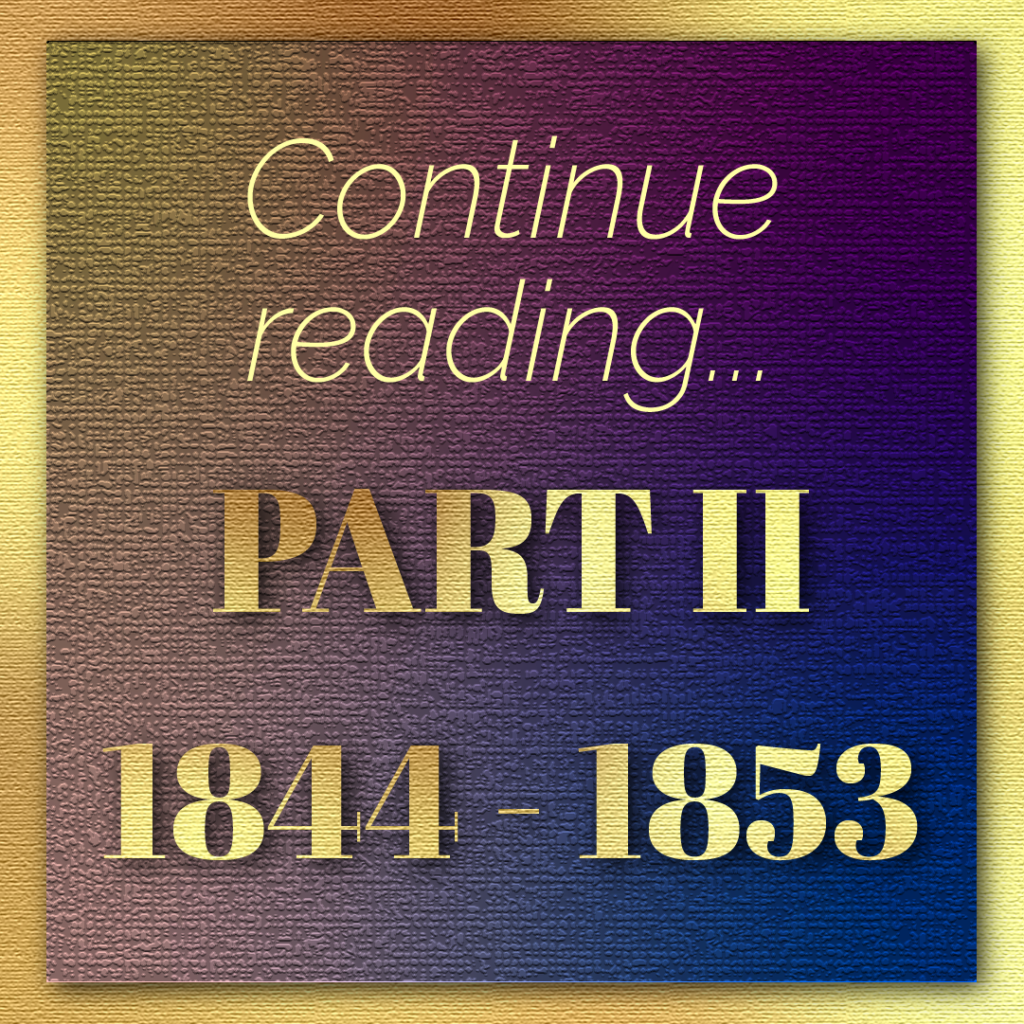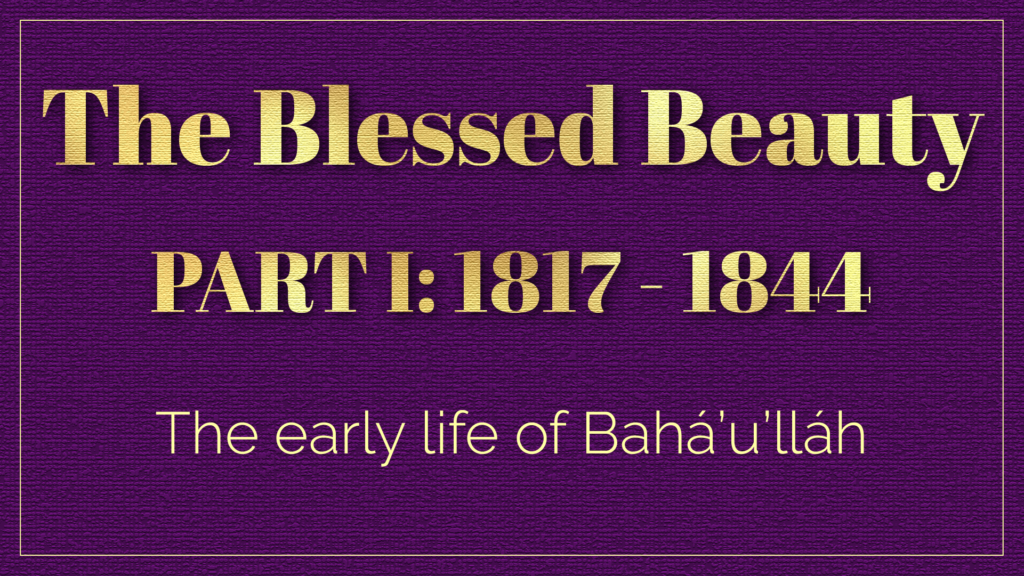
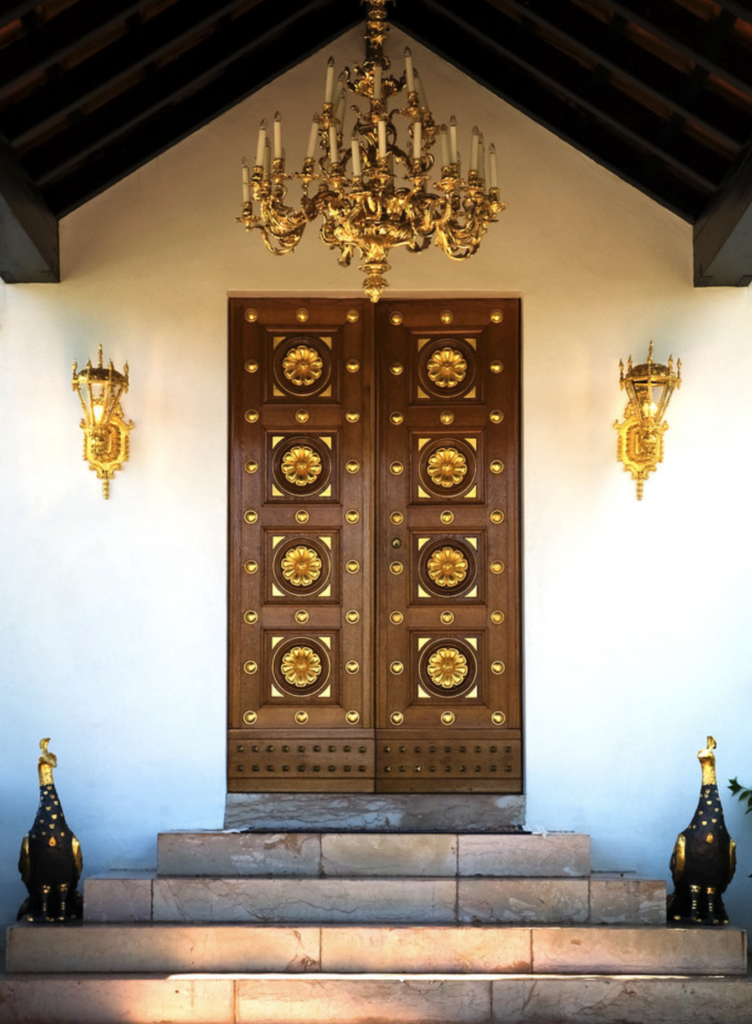
Source: Flickr.
Written and illustrated by Violetta Zein
“He Who is everlastingly hidden from the eyes of men can never be known except through His Manifestation, and His Manifestation can adduce no greater proof of the truth of His Mission than the proof of His own Person.”
Gleanings from the Writings of Bahá’u’lláh N°XX
This chronology is optimized for tablets and computers.
To read the chronology, start from the top and read down.
To navigate the chronology, move between parts with the vertical Roman numbers menu to the left of the screen, and move between sections with the numbered vertical menu to the right of the screen.
DISCLAIMER: ONLY BAHÁ’U’LLÁH’S WORDS QUOTED FROM HIS HOLY WRITINGS CAN BE CONSIDERED HIS OWN; ALL OTHER REPORTED UTTERANCES OF BAHÁ’U’LLÁH SHOULD BE VIEWED AS PILGRIM NOTES.
This part covers the life of Bahá’u’lláh from His birth in 1817 to the age of 27 in 1844.
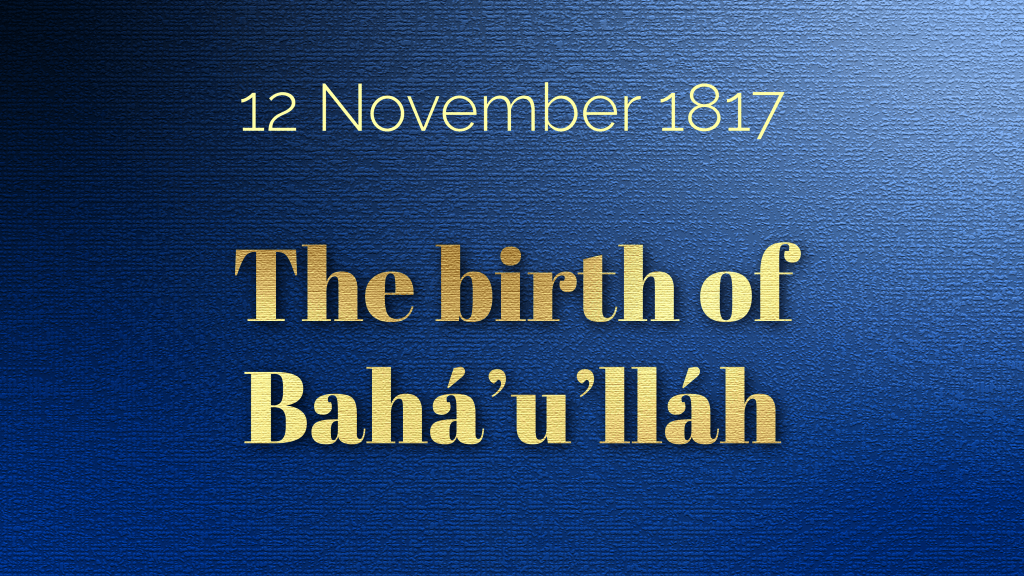
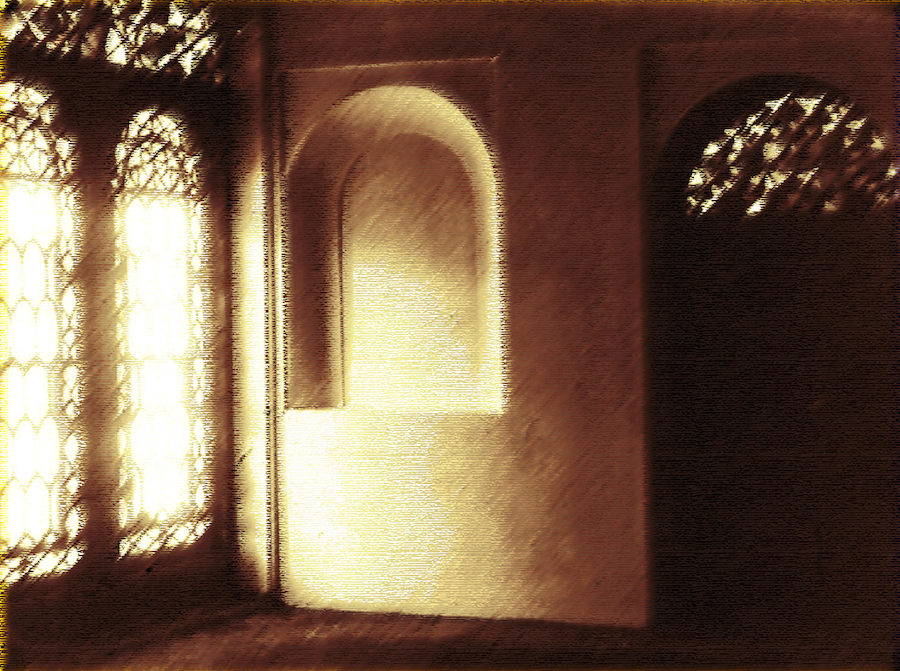
A photograph of the room in Ṭihrán where Bahá'u'lláh was born, from the book Land of Resplendent Glory, by the International Bahá'í Audio-Visual Centre, 1971. Source: Bahá'u'lláh: The Glory of God blog. Note: Because the scan of the photograph was of poor quality, the image has been modified with texture and effects to emphasize the light entering through the windows.
On 12 November 1817, at the hour of dawn, Mírzá Buzurg, Vazir-i-Nuri, and his wife Khadíjih Khánum welcomed their third child into the world: Mirza Husayn-'Ali of Núr.
With the birth of Bahá'u'lláh, an age-old prophecy was fulfilled, and nine hundred kilometers away in Mashhad, Shaykh Aḥmad-i-Aḥsá’í felt the dawning of the promised Dispensation foreshadowed in the traditional utterance:
“One of the most mighty signs that shall signalise the advent of the promised Hour is this: ‘A woman shall give birth to One who shall be her Lord.’”
H.M. Balyuzi, Bahá'u'lláh: The King of Glory, page 19.
Nabil, The Dawnbreakers, Page 12.
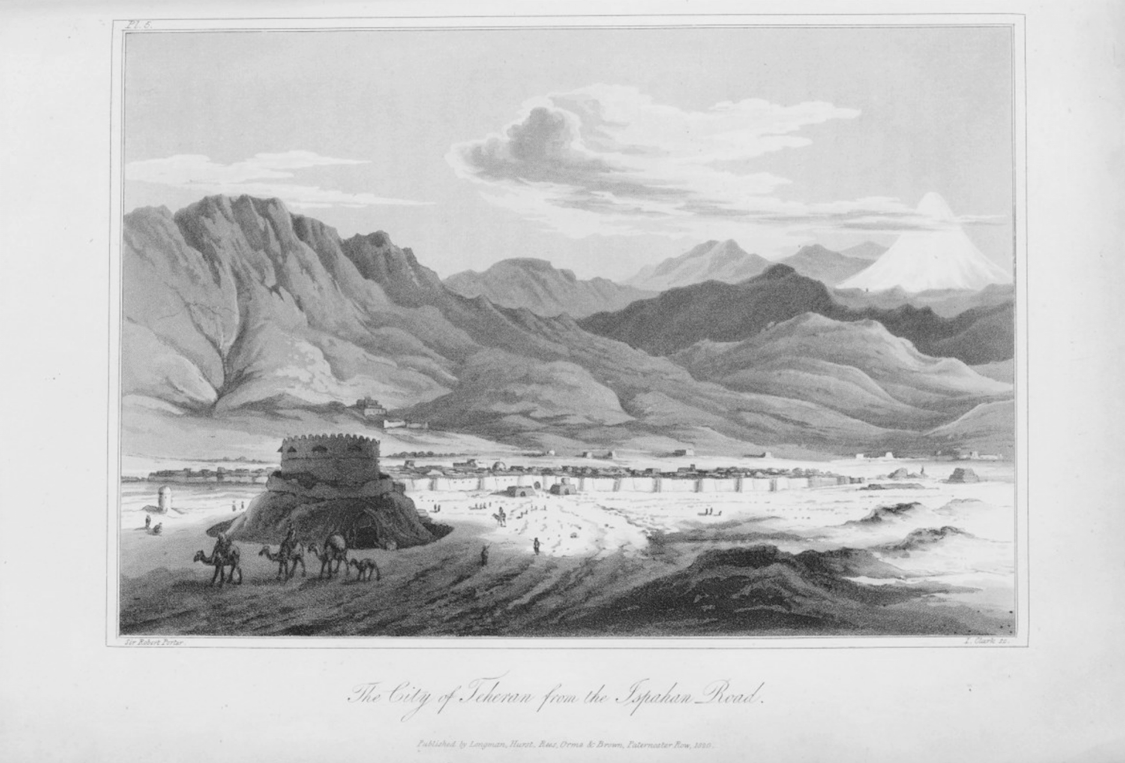
A view of Tihrán in 1820, three years after Bahá'u'lláh was born. Source: Engraved by I. Clark after Sir Robert Ker Porter and published by Longman, Hurst, Rees, Orme and Brown in the book "Travels in Georgia, Persia, Armenia, Ancient Babylonia", from the website Royal Academy.
The boy who is born this day will later be known as Bahá'u'lláh and is of royal Persian blood. On the side of His father, He is a descendent of Zoroaster and the Sásáníyán kings of Persia. Through His mother, He is descended from Abraham through Katurah and Jesse, King David's father.
To Bahá'ís, Bahá'u'lláh's birth is the fulfillment of one of the most celebrated Biblical prophecies of all time, Isaiah 9:6: For unto us a child is born, unto us a son is given: and the government shall be upon his shoulder: and his name shall be called Wonderful, Counsellor, The mighty God, The everlasting Father, The Prince of Peace.
Bahá'u'lláh will confirm this 52 years hence and thousands of kilometers away, in a Tablet He reveals for Pope Pius IX in 'Akká, where He states: This is that peerless One foretold by Isaiah, and the Comforter concerning Whom the Spirit had covenanted with you. Open your eyes, O concourse of bishops, that ye may behold your Lord seated upon the Throne of might and glory.
Shoghi Effendi, God Passes By, Chapter XII: Bahá'u'lláh's Incarceration in 'Akká (Continued)
The Bible, King James Version, Isaiah 9:6.
Bahá'u'lláh, The Summons of the Lord of Hosts, Tablet to Pope Pius IX
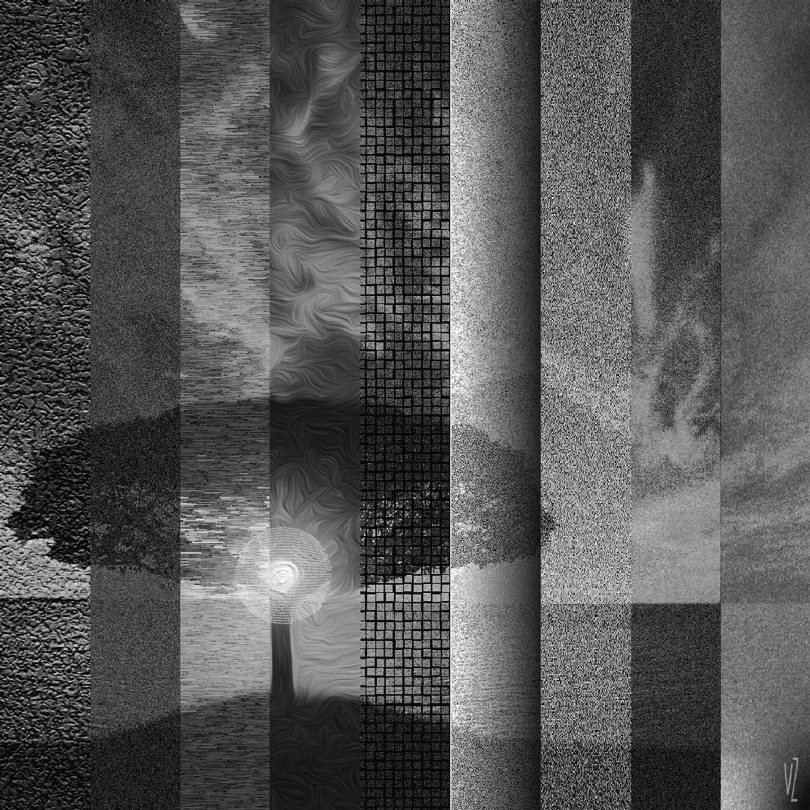
Abstract interpretation of the Titles of Bahá'u'lláh: "Bahá" is represented in its abjád numerical form by the nine vertical sections of the scene; Bahá'u'lláh, the Glory of God is symbolized both by the sun and tree imagery, the “Branch” Who “shall grow up out of His place,” and “shall build the Temple of the Lord.” the "pre-existent Root," the "Tree beyond which there is no passing," and all the titles of Bahá'u'lláh in bold in the section below are present in the translucent orb in front of the sun. © Violetta Zein.
Bahá'u'lláh, the prophet-founder of the Bahá'í Faith is considered by Bahá'ís to be the Judge, the Lawgiver and Redeemer of all mankind, the Organizer of the entire planet, as the Unifier of the children of men, the Inaugurator of the long-awaited millennium, the Originator of a new “Universal Cycle,” the Establisher of the Most Great Peace, the Fountain of the Most Great Justice, the Proclaimer of the coming of age of the entire human race, the Creator of a new World Order, and the Inspirer and Founder of a world civilization.
He was prophesied in the Old Testament as the “Everlasting Father”; the “Lord of Hosts” come down “with ten thousands of saints.” Hundreds of references to Bahá'u'lláh can be found in most of the Books of the ancient Testament, such as the “Glory of the Lord,” the “Everlasting Father,” the “Prince of Peace,” the “Wonderful,” the “Counsellor,” the “Rod come forth out of the stem of Jesse,” the “Lord” Who “shall be king over all the earth,” the “Branch grown out of His roots,” Who “shall be established upon the throne of David,” Who “will come with strong hand,” Who “shall judge among the nations,” Who “shall smite the earth with the rod of His mouth, and with the breath of His lips slay the wicked,” and Who “shall assemble the outcasts of Israel, and gather together the dispersed of Judah from the four corners of the earth,” the “Lord of Hosts” and the “King of Glory, ” the “Desire of all nations,” and the “Branch” Who “shall grow up out of His place,” and “shall build the Temple of the Lord,” among many others.
In the Gospels, references to Bahá'u'lláh are no less numerous, including the “Son of Man” Who “shall come in the glory of His Father” “in the clouds of heaven with power and great glory,” with “all the holy angels” about Him, and “all nations” gathered before His throne, the “Prince of this world,” the “Comforter” Who will “reprove the world of sin, and of righteousness, and of judgment,” as the “Spirit of Truth” Who “will guide you into all truth,” Who “shall not speak of Himself, but whatsoever He shall hear, that shall He speak,” the “Lord of the Vineyard,” the “Glory of God,” the “Alpha and Omega,” the “Beginning and the End,” and “the First and the Last.”
For Shí‘ah Islám He is considered to be the return of the Imám Ḥusayn;
For Sunní Islám Bahá'u'lláh is none other than the descent of the “Spirit of God” (Jesus Christ);
Bahá'u'lláh is the promised Sháh-Bahrám of Zoroastrians;
For the Hindus, Bahá'u'lláh is the “immaculate” reincarnation of Krishna the “Most Great Spirit,” and the “Tenth Avatar.”
And Bahá'u'lláh is not only the Fifth Buddha, but He is Who is referred to in the prophecy attributed to Buddha Himself that “a Buddha named Maitreye, the Buddha of universal fellowship” should, in the fullness of time, arise and reveal “His boundless glory.”
Source: Shoghi Effendi, God Passses By, Chapter VI: The Birth of the Bahá'í Revelation
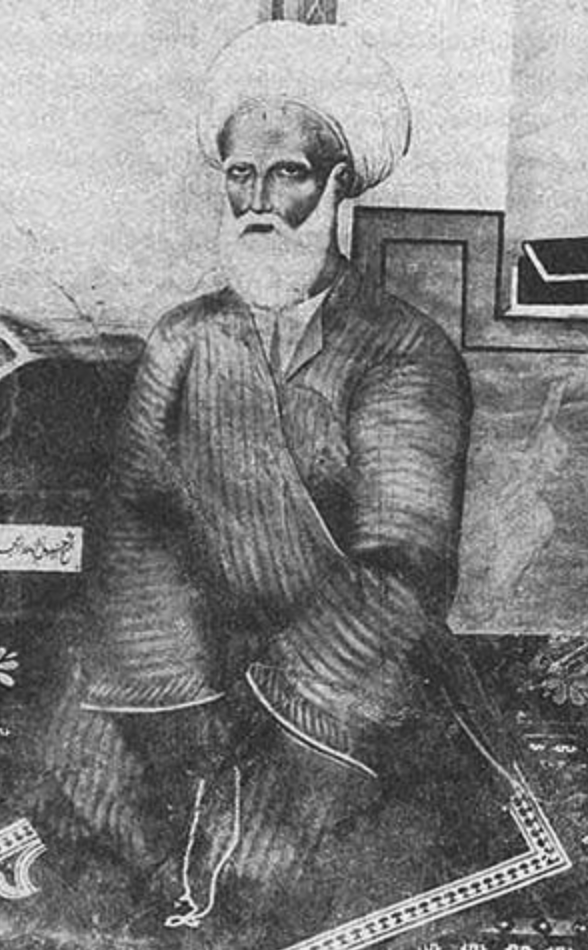
Undated and anonymous portrait of Shaykh Aḥmad, the prominent 19th-century Shia Muslim theologian and jurist who proclaimed the advent of the Promised One. Wikimedia Commons.
As the Revelation of the Báb grew near, Shaykh Aḥmad-i-Aḥsá’í, a prominent 19th-century Shi'áh Muslim theologian, became certain that the Promised One of Islám would soon appear. He began to guide people to inner truths and meanings, the secrets and mysteries of the Qur’án and His followers became known as Shaykhís.
In 1817, Shaykh Aḥmad-i-Aḥsá’í followed a powerful calling to Persia, first in Yazd, then Mashhad, preparing those he met for the coming of a new Manifestation of God. In Mashhad, he became convinced the Promised One’s birth was at hand, but prophesied that the people would fail to recognize Him and unite in embracing His Faith.
Shaykh Aḥmad-i-Aḥsá’í’s was strongly attracted to Núr, Bahá'u'lláh’s home province in Mázindarán, and he stopped in Ṭihrán on his journey. It was around this time that Bahá'u'lláh was born. Shaykh Aḥmad-i-Aḥsá’í yearned to spend the rest of his life in service to the newborn Promised One, would utter constant prayers for Bahá'u'lláh’s safety, and made repeated references to "Ḥusayn" "'Alí", the names of Bahá'u'lláh. Until his death, Shaykh Aḥmad-i-Aḥsá’í emphatically proclaimed that the promised Dispensation was inevitable.
Nabíl, The Dawn-Breakers, pages 12-14.
'Abdu'l-Bahá, Twelve Table Table Talks Given by 'Abdu'l-Bahá in 'Akká, Shaykh Aḥmad and Siyyid Káẓim.
Wikipedia: Shaykh Ahmad.
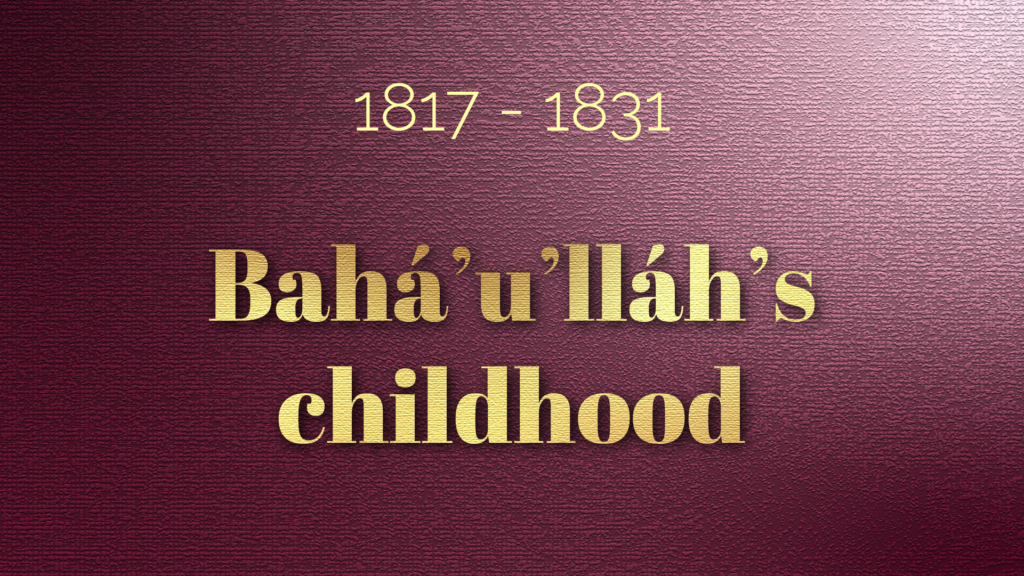
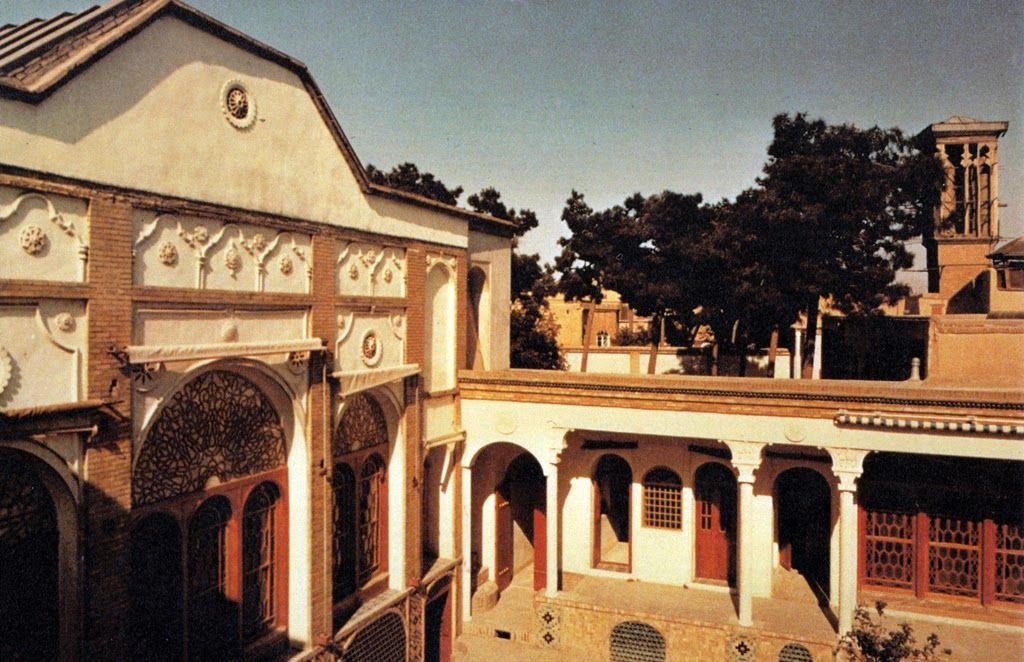
The house of Mírzá Buzurg, Bahá'u'lláh's father, where He was born on 12 November 1817, at dawn. Source: Uplifting Words.
'Abdu'l-Bahá tells us that Bahá'u'lláh's mother, Khadíjih Khánum was attached to the infant to such a degree that she could not be away from Him, even for a moment.
Abdu'l-Bahá also says that Bahá'u'lláh's demeanour as a baby astonished His mother, quoting Khadíjih Khánum as saying:
"This child never cries, He is so unlike other babies who cry and scream and are forever restless while in the nursing stage..."
Baharieh Rouhani Ma'ani, Leaves of the Twin Divine Trees, page 76
'Alí -Akbar Furútan, Memories of Bahá'u'lláh, page 1.
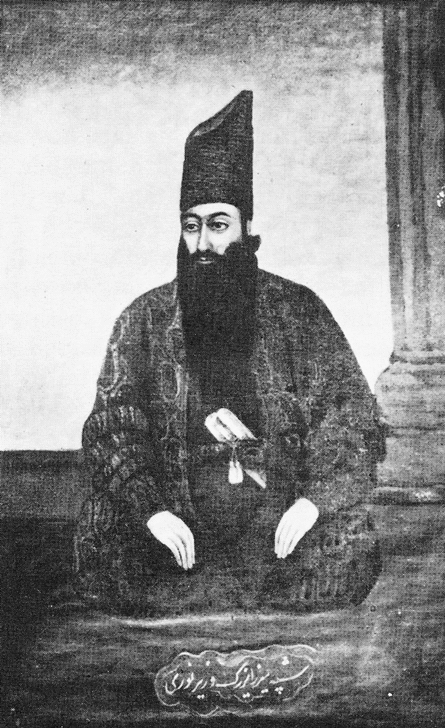
Mírzá `Abbás-i-Núrí, more commonly known as Mírzá Buzurg, father of Bahá'u'lláh and Mírzá Musá. Source: Bahaipedia.
Sometime during Bahá'u'lláh's childhood, we do not know when, Khadijih Khanum and Mírzá Buzurg welcomed another son into their home, Bahá'u'lláh's younger and only full brother, Mírzá Músá, on whom Bahá'u'lláh will bestow the title Áqáy-i-Kalím (His Eminence Kalím). Even as a nursing infant, Mírzá Músá showed an extraordinary attachment to his older brother Bahá'u'lláh.
The names and titles of Mírzá Músá are significant. Músá, his birth name, is the Arabic name for Moses, the one who spoke to the Burning Bush on Mount Sinai, and Kalím, part of the title bestowed on him by Bahá'u'lláh later in life, is one of the titles of Moses, translated as "He who conversed with God.” Both Mírzá Músá’s name and title prophesy the lifelong role he would play at Bahá'u'lláh’s side.
Thank you to Earl Redman for the year of birth of Mírzá Músá. Source: Fikri, 'Abdu'l-Hussayn, Ḥawáríyyú Ḥaḍrat-i-Bahá’u’lláh, p. 13
‘Abdu’l-Bahá. Memorials of the Faithful: His Eminence Kalím (Mírzá Músá).
Shoghi Effendi, God Passes By.
Bahaipedia: Mírzá Músá.
Wikipedia: Mírzá Músá.
With thanks to Dr. Iskandar Hai for clarifications on the meaning of Mírzá Músá's names.
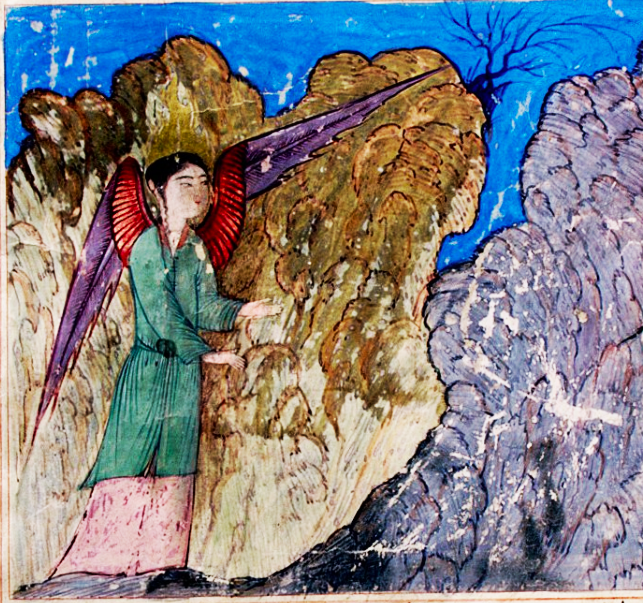
Muhammad's Call to Prophecy and the First Revelation: Folio from a 1425 manuscript of the Majma' al-Tawarikh (Compendium of Histories), made in Herat, Afghanistan, watercolor, silver, and gold on paper. This illustration depicts Gabriel's first appearance to Muhammad. The Archangel commands Muhammad to recite God's word. Out of respect, the Prophet Muḥammad has been cropped from this image. Source: The Metropolitan Museum of Art.
Bahá'u'lláh recalls a childhood incident in a Tablet He addressed to a Bahá'í of Shíráz which gives us a clear understanding of His keen spiritual awareness from a very young age.
In the Persia of Bahá'u'lláh’s childhood, the height of a divine’s turban was thought to be proportional to their learning and wisdom. One day, Bahá'u'lláh witnessed two hugely-turbaned divines expounding on theological matters to two ladies, separated from them by a veil, as was the custom.
The divines were debating obscure mystical facts such as whether the Angel Gabriel had a higher station than the first Imám’s slave. Even as a child, Baha'u'llah was astonished by their pointless argument, since it was perfectly clear that no one could be compared in station to the Angel Gabriel, through whom the Holy Spirit had descended on the Prophet Muḥammad.
H.M. Balyuzi, Bahá'u'lláh: The King of Glory, page 21.
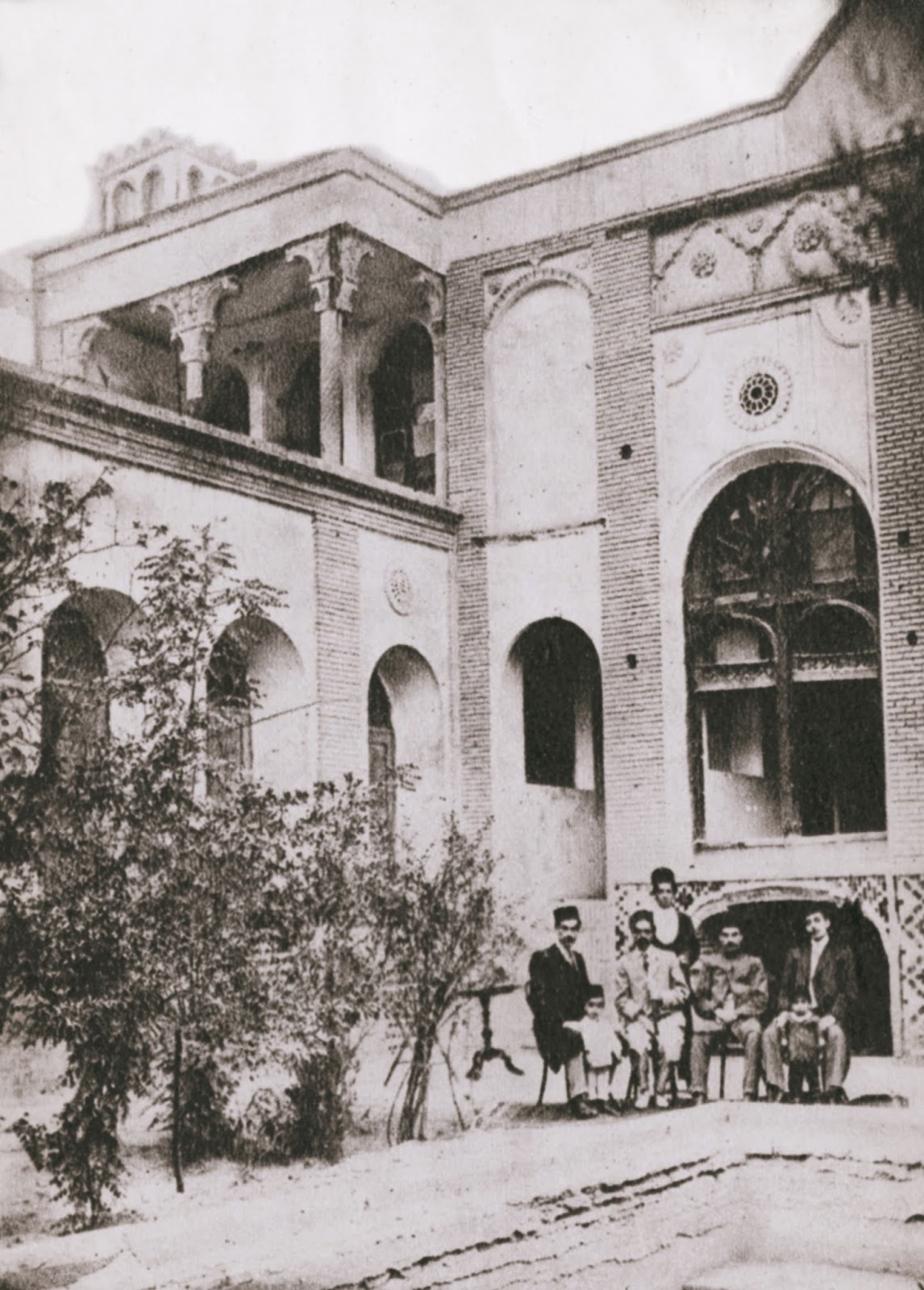
The house of Mírzá Buzurg, Bahá'u'lláh's father, decades later with a group of visiting Bahá'ís sitting in front. Source: Baha'u'llah - The Glory of God blog.
'Abdu'l-Baha tells us a touching story from when Bahá'u'lláh was about seven years old and was out strolling with His parents. His mother, Khadíjih Khánum, admiring the gracefulness of His body, remarked to His father that He was slightly short in stature.
Bahá'u'lláh's father, Mírzá Buzurg, replied: "That matters not. Do you not know how intelligent He is and what a wonderful mind He has!" Mírzá Buzurg explained that Baha'u'llah was like a flame of fire, and even as a young child, He was more mature than adults, reassuring his wife, saying that it mattered not at all if He was not tall.
H.M. Balyuzi, Bahá'u'lláh: The King of Glory, page 20.
Baharieh Rouhani Ma'ani, Leaves of the Twin Divine Trees, page 76
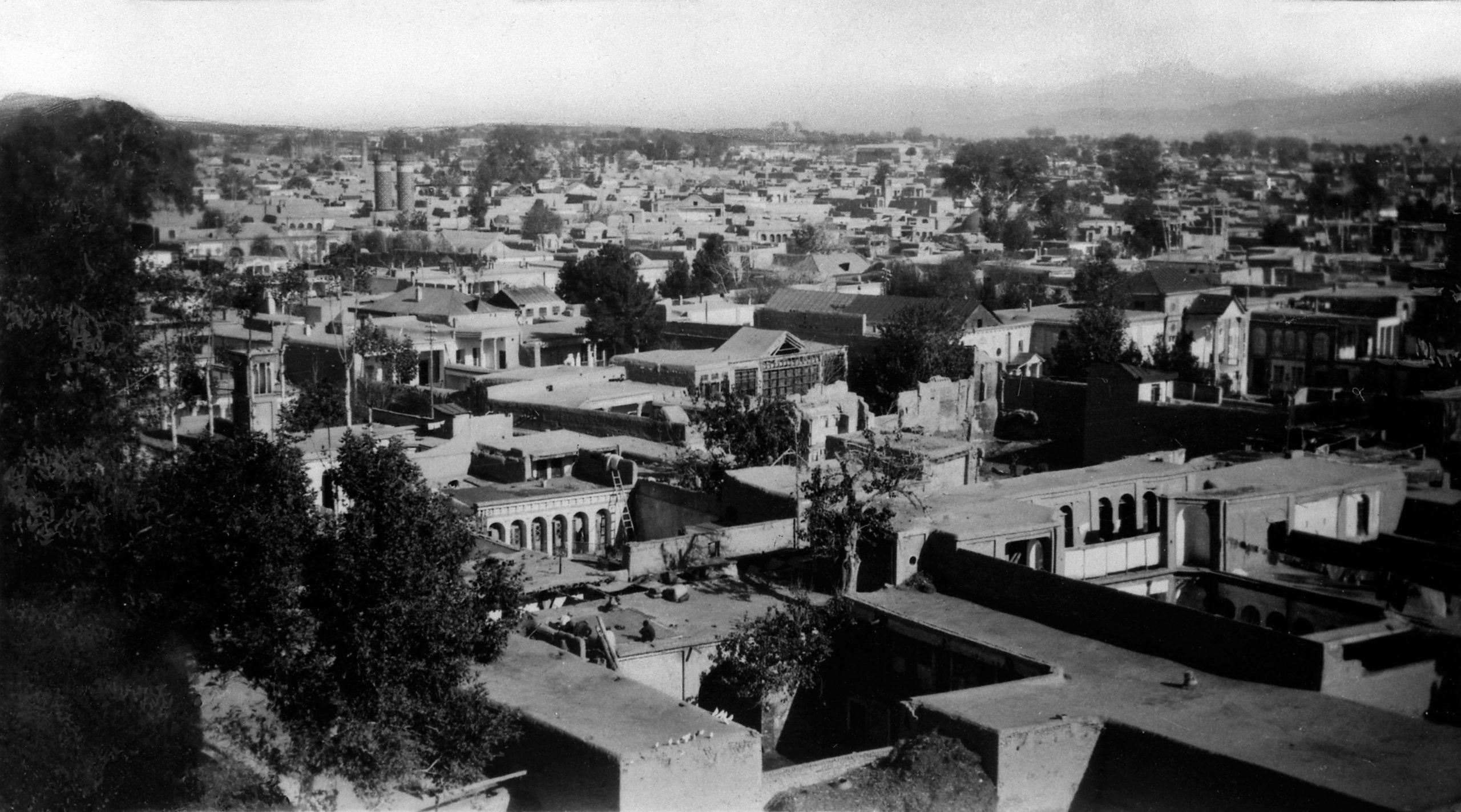
The city of Ṭihrán, Persia, where Bahá’u’lláh was born in 1817, c. 1930. Source: Bahá'í Media Bank, © Bahá'í International Community.
'Abdu'l-Bahá tells us that from His earliest childhood, Bahá'u'lláh distinguished Himself among His relatives and friends. He was far advanced, well beyond His years in His knowledge, wisdom and intelligence, causing people to exclaim "This child has extraordinary power." Because Bahá'u'lláh was so precocious, and current superstition was that precocious children did not reach maturity, people also often said "Such a child will not live."
‘Abdu’l-Baha, The Promulgation of the Universal Peace, 18 April 1912
J.E. Esslemont, Bahá'u'lláh and New Era.
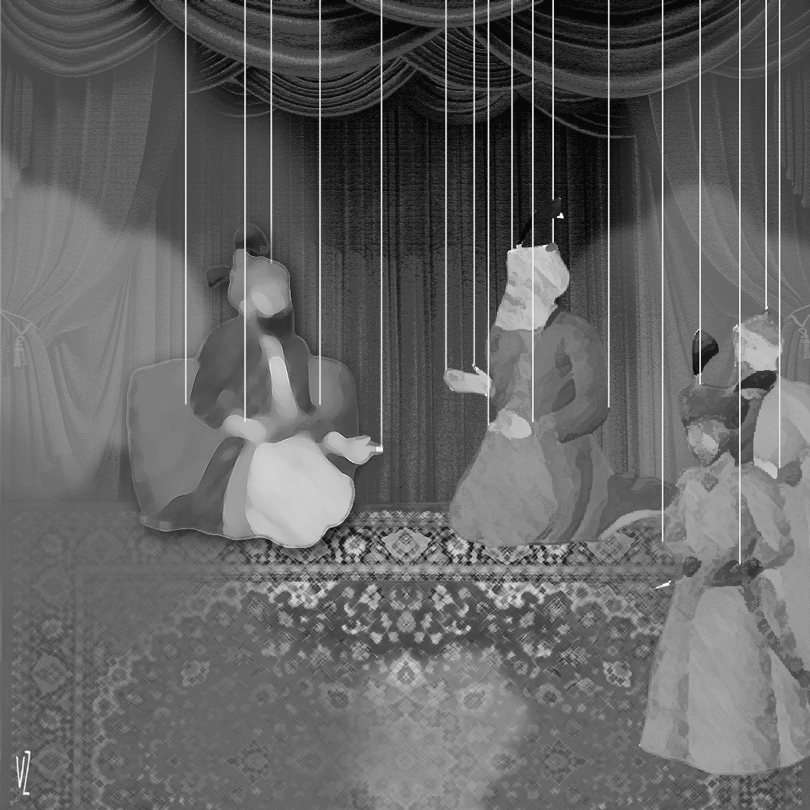
Abstract interpretation of the puppet show experience in Bahá'u'lláh's childhood which caused Him to view the trappings of this world as vanishing before His eyes. © Violetta Zein.
Before Bahá'u'lláh turned 14, an event of enormous importance took place, which not only changed Bahá'u'lláh's perspective forever, and which He would think about for the rest of His life.
In Bahá'u'lláh’s own words, He “swears” that "Ever since that day, all the trappings of the world have seemed in the eyes of this Youth akin to that same spectacle. They have never been, nor will they ever be, of any weight and consequence, be it to the extent of a grain of mustard seed."
This is the story of the puppet show.
One of Bahá'u'lláh’s older brothers was getting married, and, on the last day of the week-long festivities, a puppet show of the play “Sháh Sulṭán Salím” was presented to the wedding guests and a crowd of princes, dignitaries, and notables. Bahá'u'lláh was seated in one of the upper rooms of the house, watching.
The plot of the play was the regal arrival of the King sentencing a thief to death, his execution, and a rebellion against the king. The sound effects were loud, blood poured from the thief’s neck after his head was chopped off, a fanfare of trumpets accompanied the king, smoke filled the stage when a volley of shots was fired to welcome him, cannons sounded real.
Bahá'u'lláh followed the entire play with great amazement. About twenty minutes after the play ended,a man emerged from behind the tent, carrying a box under his arm, and Bahá'u'lláh asked him what was in the box. The puppeteer responded:
“All this lavish display and these elaborate devices, the king, the princes, and the ministers, their pomp and glory, their might and power, everything you saw, are now contained within this box.”
Bahá'u'lláh would never again see humanities' attachment to the "trappings of the world" in the same light, and, nearly forty years later, Bahá'u'lláh would recount the entirety of this story in very great detail, to ‘Álí Páshá, marveling that “men should pride themselves upon such vanities,” and stating “Never have I looked upon any thing save that I have seen extinction before it; and God, verily, is a sufficient witness!”
Bahá'u'lláh, The Summons of the Lord of Hosts, The Lawḥ-i-Ra’ís (Second Tablet addressed to ‘Álí Páshá shortly after Bahá'u'lláh's arrival in 'Akká, 31 August 1868)
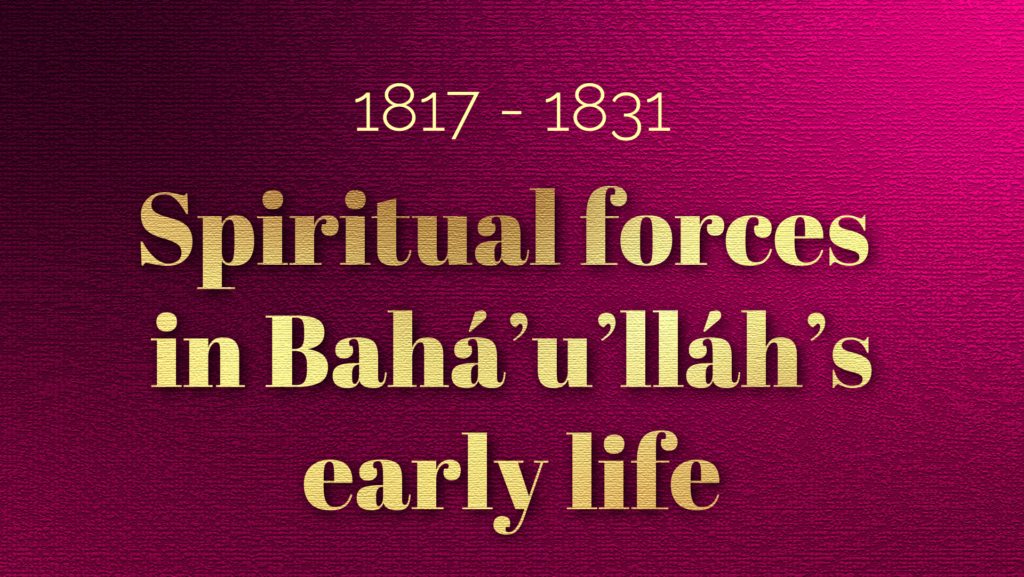
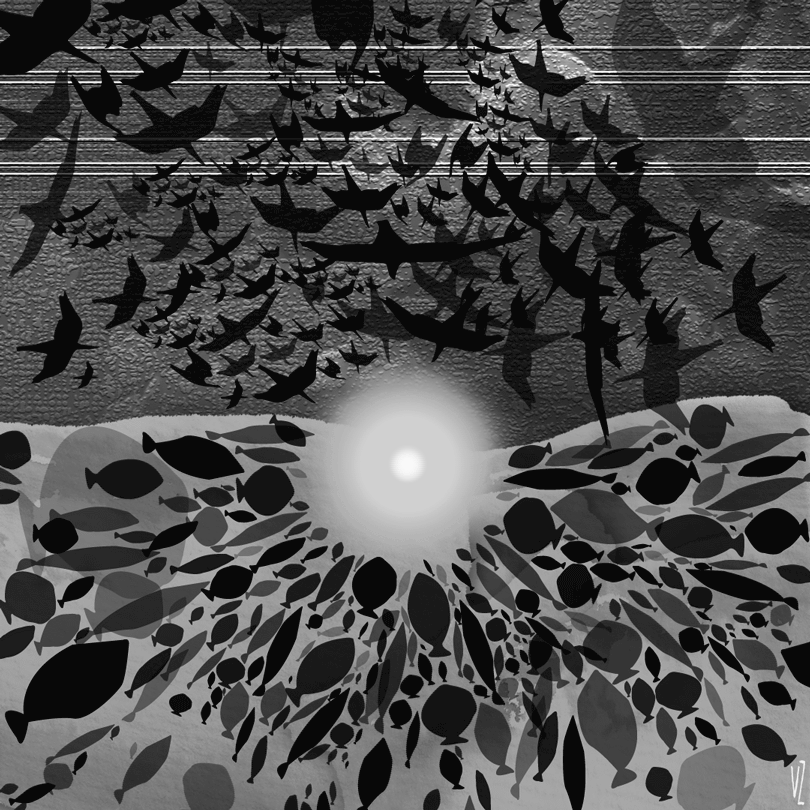
The Dream of Bahá'u'lláh - An abstract interpretation. © Violetta Zein.
At the age of five or six Bahá'u'lláh described a dream He had to His father. In the dream Bahá'u'lláh found Himself in a garden. Huge birds were attacking Him from every side, but they were unable to inflict any harm on Him. Then, Bahá'u'lláh went into the sea and, as He was swimming, the birds of the air and the fish of the sea attacked Him, and again, He was unharmed.
Bahá'u'lláh's father summoned a man who claimed to be able to interpret dreams. The man said: "This dream indicates that the Child shall be the founder of a great Cause, and that all the leaders and learned men throughout the world will attack Him, but, like the birds and the fish, they shall do no harm. He will be victorious over all." Bahá'u'lláh’s childhood dream could clearly be said to be prophetic, so accurately did it foretell Bahá'u'lláh’s lifelong supremacy over His enemies.
H.M. Balyuzi, Bahá'u'lláh: The King of Glory, pages 19-20.
'Alí Akbar Furutan, Stories of Baha’u’llah, pages 1-2.
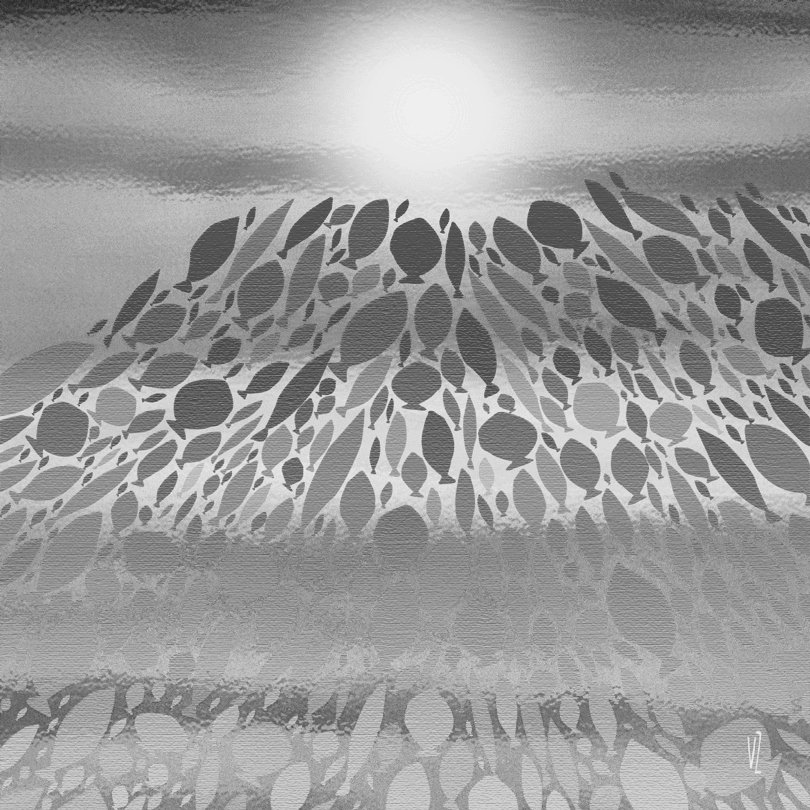
Abstract interpretation of the dream of Mírzá Buzurg. © Violetta Zein.
When Bahá'u'lláh was still a child, His father dreamt that Bahá'u'lláh was swimming in a vast, limitless ocean illuminated by His body's splendor. Bahá'u'lláh’s long, jet-black hair flowed profusely above the waves, and a multitude of fish gathered, each one holding the extremity of one of Bahá'u'lláh's hairs. The fish, fascinated by His radiance, followed Him in whichever direction He swam. Despite the fish holding on to His hair, Bahá'u'lláh was entirely unharmed, and He moved above the waters free and unrestrained.
Mírzá Buzurg was so impressed by this dream that he summoned a renowned soothsayer to interpret it. The soothsayer, in a moment of prescient clarity about Bahá'u'lláh's future glory, declared:
"The limitless ocean that you have seen in your dream, O Vazir, is none other than the world of being. Single-handed and alone, your son will achieve supreme ascendancy over it. Wherever He may please, He will proceed unhindered. No one will resist His march, no one will hinder His progress. The multitude of fishes signifies the turmoil which He will arouse amidst the peoples and kindreds of the earth. Around Him will they gather, and to Him will they cling. Assured of the unfailing protection of the Almighty, this tumult will never harm His person, nor will His loneliness upon the sea of life endanger His safety."
When the soothsayer was taken to meet Bahá'u'lláh, he carefully examined His features, and was charmed by His appearance, praising every trait of His countenance, stating that in every expression of Bahá'u'lláh's face, he could perceive a sign of His concealed glory, and he praised the child with so much admiration, that Mírzá Buzurg became even more passionately devoted to Bahá'u'lláh, and even more filled with hope and confidence in his extraordinary Son.
Nabíl, The Dawn Breakers, Chapter V: Bahá'u'lláh's Journey to Mazindárán
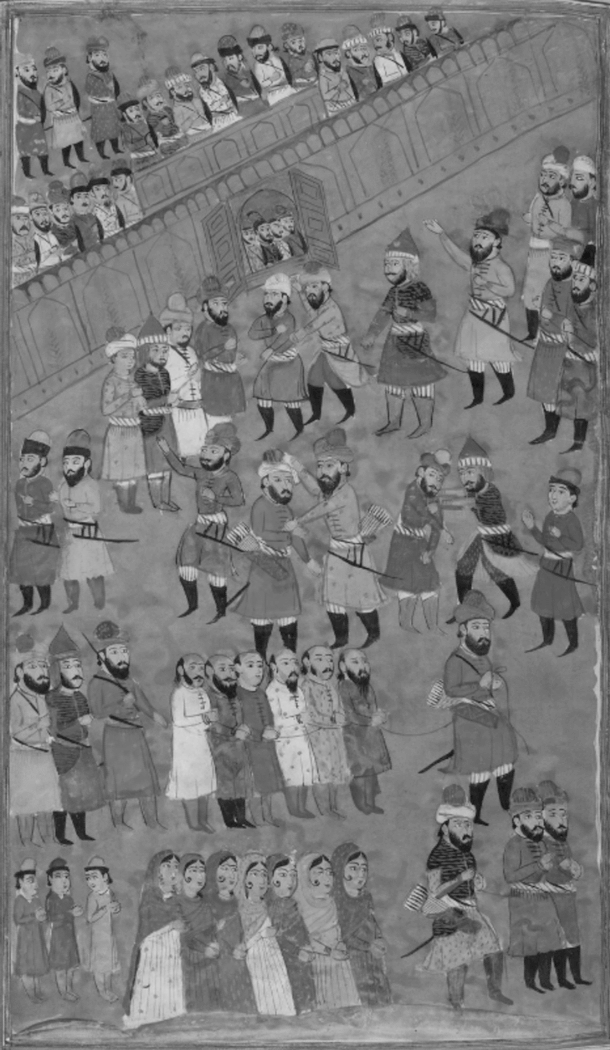
Seizure of the Banú Qurayza stronghold. Illustration from Ḥamlah-i Ḥaydarí, by Muḥammad Rafi' Bāzil. Source: Wikimedia Commons.
When Bahá'u'lláh was a child, He read Mullá Muḥammad Báqir-i-Majlisí’s account of the massacre of the tribe of Banú Qurayẓah, allies of the Muslims who had betrayed them in battle. When they were brought back to Mecca, the Prophet Muḥammad handed their judgment to the leader of a Medinan tribe who had the men beheaded and the women and children sold into slavery.
After reading this account, Bahá'u'lláh “immediately became so grieved and saddened that the Pen is unable to recount it,” and “with the ocean of forgiveness and boundless mercy before His eyes, He beseeched the One True God, exalted be His glory, at that time for that which would be the cause of universal love, fellowship, and the unity of all the peoples of the earth.”
Bahá'u'lláh’s entire being was affected by reading this story and “His comportment, speech and thought were thrown into turmoil, a tumult that gave glad tidings of exaltation.” Bahá'u'lláh’s state of tumult was constant and uninterrupted for twelve days, “after which the waves of the ocean of utterance became manifest and the effulgences of the sun of certitude dawned.” This would culminate years later, at the time of His Revelation in the Siyáh-Chál, also a 12-day period during which Bahá'u'lláh would experience a state of transfiguration and would attain unto “the source of joy to all mankind,” and be awakened to His role as the Manifestation of God for today.
In the Tablet He revealed describing the profound spiritual experience that followed learning about the massacre of the Banú Qurayẓah, Bahá'u'lláh describes a desire that formed in His mind as a child to be the instrument of bringing unity and harmony to the world. In the Tablet, He describes how this desire was realized from early childhood over the course of the rest of His life. The twelve-day state of transfiguration Bahá'u'lláh experienced can only be described as an early childhood experience of His future station of Prophethood.
Adib Taherzadeh, The Revelation of Bahá'u'lláh Volume 2: Adrianople 1863-1868, page 348.
Moojan Momen, Two Episodes from the Life of Bahá'u'lláh in Iran, published in Lights of Irfan, 20, pages 153-155 and 157.
Fádil Mázandarání, Asrár al-Áthár volume 2, pages 17-18.
Ishráq-Khávarí, Má’idih-yi Ásmání, volume 7, pages 136.
Wikipedia: Banu Quarayza.
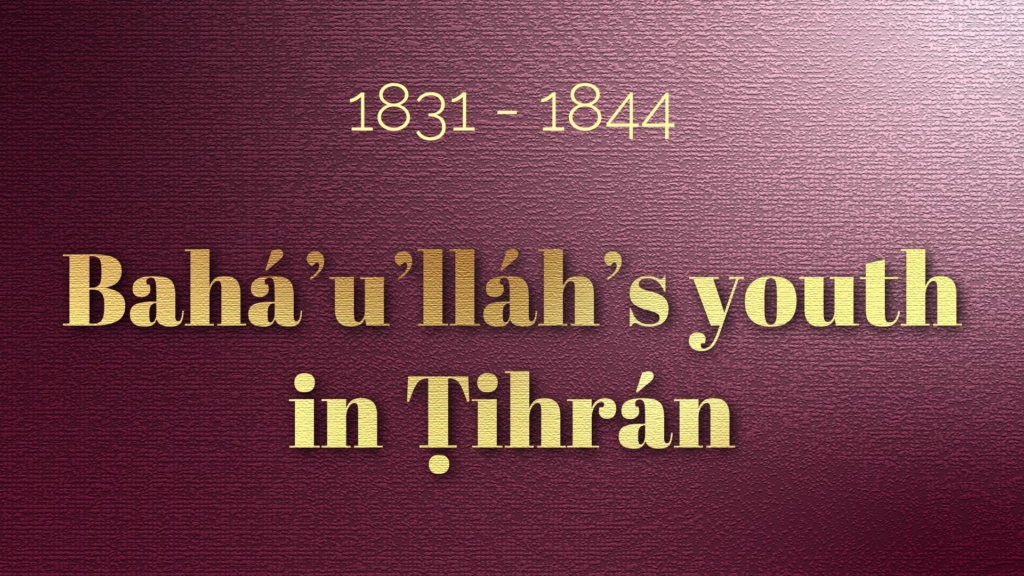
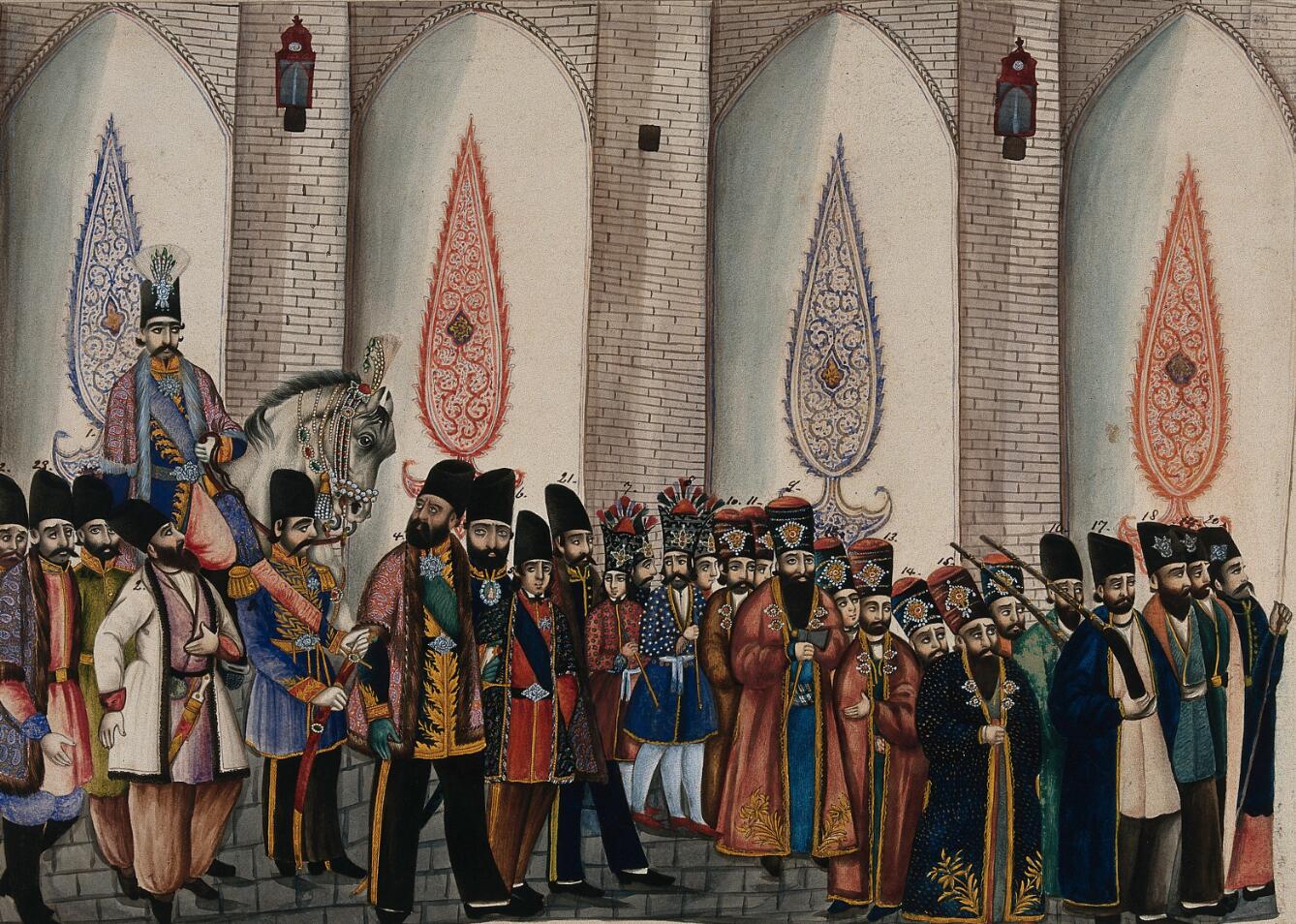
This nineteenth century scene of the Sháh of Persia accompanied by His executioners is a perfect illustration of the story below about a man's crumbling arrogance. The king of Persia sitting on a horse with his entourage of officers, bodyguards, footmen and executioners around him. Gouache painting by a Persian artist, from the website Wellcome Collection.
When Bahá'u'lláh was a youth, He attended a meeting where the celebrated Ṣúfí teacher, Mirza Naẓar-'Ali of Qazvín, highly regarded by the Sháh, was speaking, rather arrogantly about himself.
Mirza Naẓar-'Ali said "Should my servant come to me and say that Jesus the Christ was at the door, asking for me, my detachment is such that I would express no wish to see Him." At these conceited words, the audience murmured assent and flattery or kept silent.
Only Bahá'u'lláh spoke up. One of the few things that raised anger in His heart was any disrespect towards a Messenger of God, although, even in anger, Bahá'u'lláh admonished the offender with kindness and calm. He turned to Mirza Naẓar and said*:
"You are very close to the person of the sovereign and he is very devoted to you, but if the chief executioner with ten of his men were to come to this door and tell you that the monarch wanted to see you, would you take it calmly or would you be perturbed?"
Mirza Naẓar-'Ali paused for a while, then replied:
"In truth, I would feel anxious."
To which Bahá'u'lláh replied, leaving the entire assembly speechless:
"In that case, you should not make such an assertion."
*The words spoken by Bahá'u'lláh in this anecdote are not an exact quotation.
H.M. Balyuzi, Bahá'u'lláh: The King of Glory, pages 22-23.
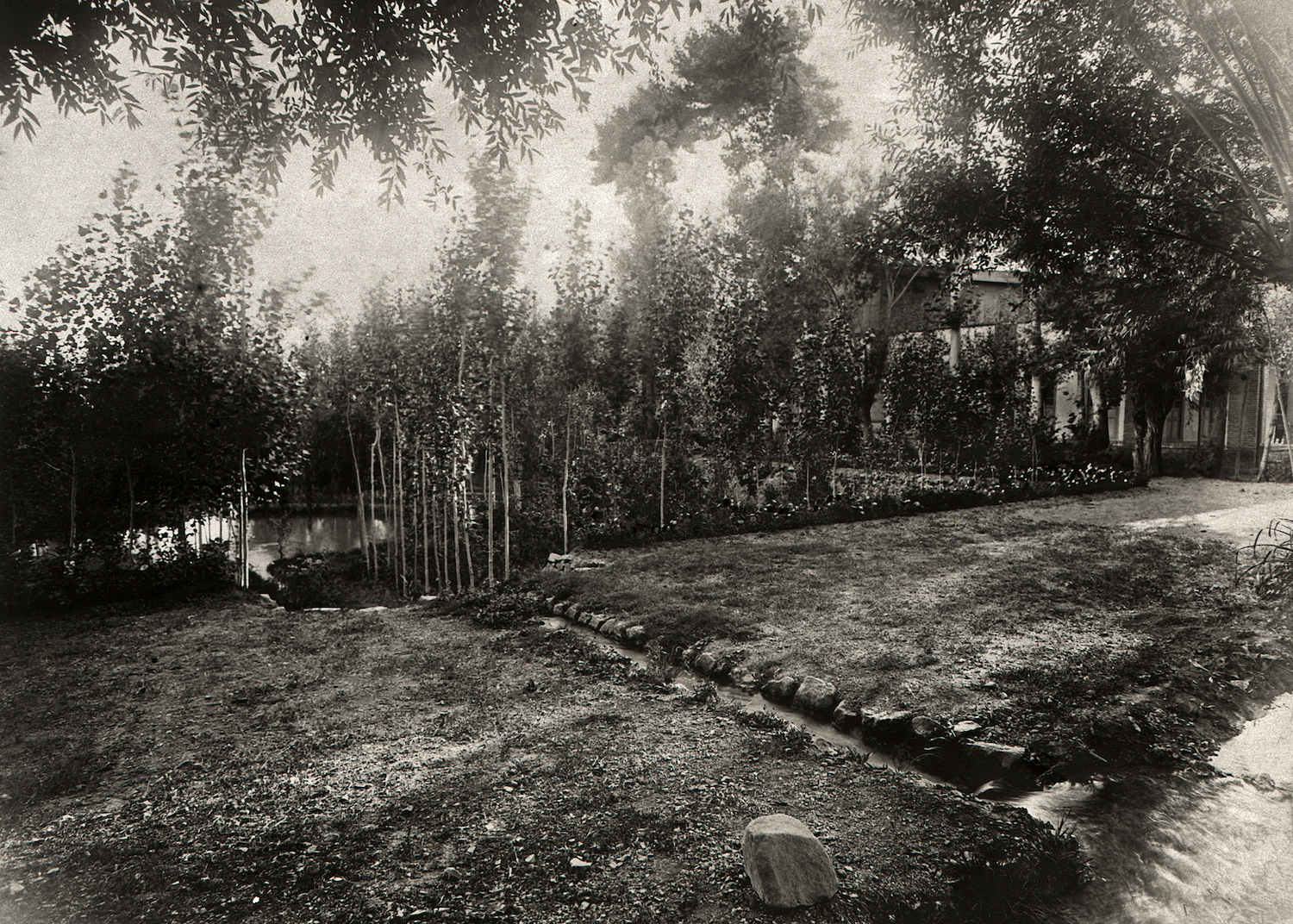
A garden at Bahá’u’lláh's house in Shimran, outside of Ṭihrán, in the early 1900s. These are the types of surroundings Bahá'u'lláh dearly loved, as a great lover of outdoor life. Photograph © Bahá'í International Community. Bahá'í Media Bank.
As Bahá'u'lláh grew through His childhood years to His adolescence, His extraordinary innate qualities shone through. Bahá'u'lláh was extremely kind and generous. And He was a great lover of outdoor life, spending most of His time in gardens and fields.
He had a strong power of attraction, felt by all. People always crowded around Him, Ministers and people of the Court would surround Him, and the children also were devoted to Him. When He was only 13 or 14 years old, Bahá'u'lláh became renowned for His learning. Not only could He fluently discuss any subject, or solve any problem He was faced with, but He also discussed matters with Muslim clergy in large gatherings, explaining intricate subjects of religious doctrine and He was always listened to with profound interest.
‘Abdu’l-Baha, The Promulgation of the Universal Peace, 18 April 1912
J.E. Esslemont, Bahá'u'lláh and New Era.
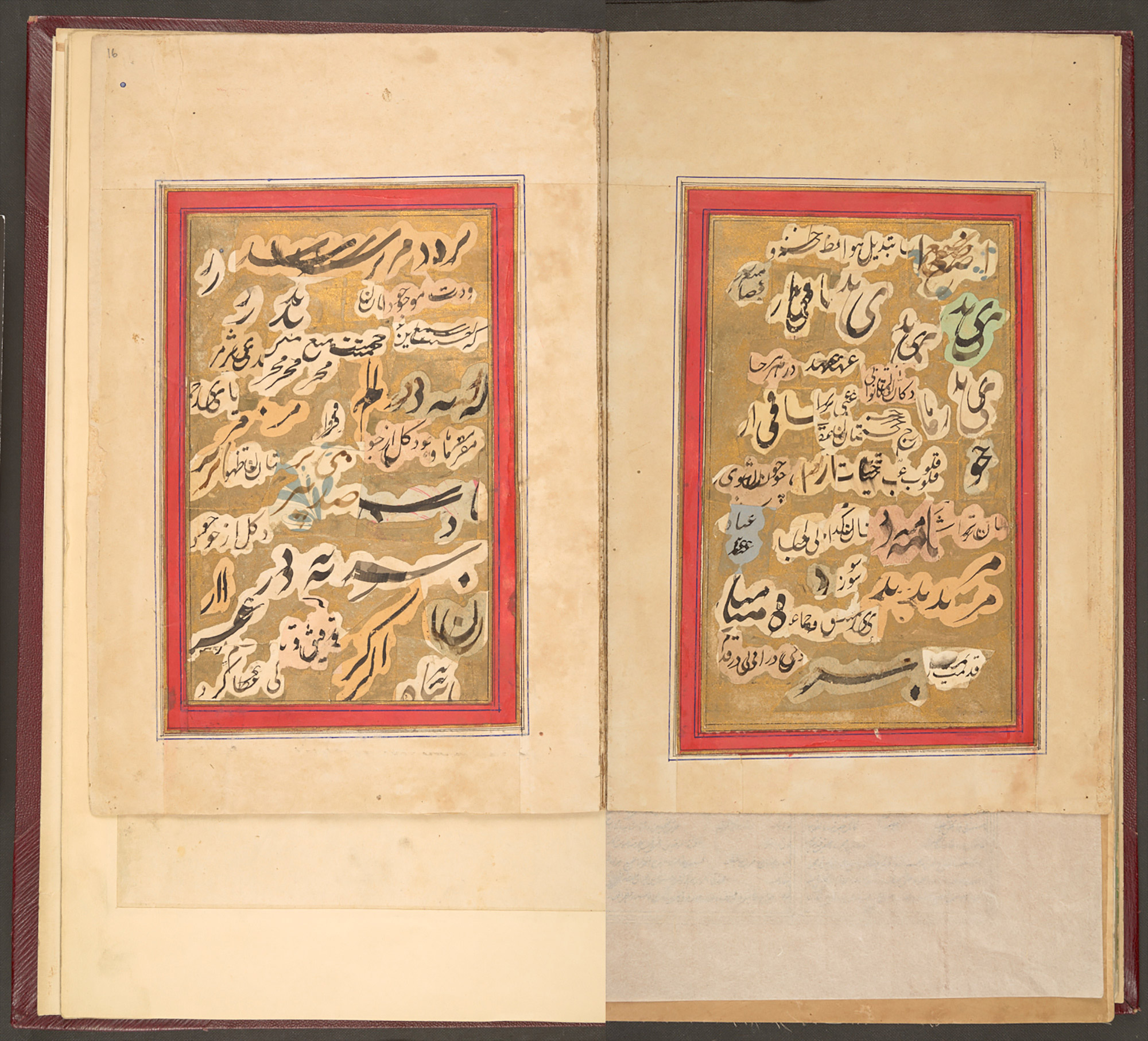
An extraordinary photograph of Bahá'u'lláh's childhood calligraphic practice, which would have formed part of His childhood education. Source: British Library: Album of Bahá'í Calligraphy (image number 6 in slideshow) Direct link to original image.
Now a teenager, Bahá'u'lláh did not attend school. He already had the innate capacity to solve the most arduous problems of all those who came to see Him. In any meeting He attended, whether it was a scientific gathering or a theological discussion, Bahá'u'lláh was inevitably the authority for explaining the most intricate and abstruse questions that were posed. Bahá'u'lláh Himself testifies that He never had a formal education:
"The learning current amongst men I studied not; their schools I entered not. Ask of the city wherein I dwelt, that thou mayest be well assured that I am not of them who speak falsely."
In the Persia of the nineteenth century, children of noble families such as Bahá'u'lláh, were trained and educated by tutors brought in the home for personal instruction in matters befitting of their station in life. Those subjects would include etiquette and good manners, horse riding, shooting, wielding a sword, calligraphy, exposure to great classical poetry, reading the Qur'án, and rarely anything beyond these subjects.
Around 1831, by the time Bahá'u'lláh, then known as Mírzá Ḥusayn 'Alí was 14 years old (the age of maturity in Islamic society), the fame of this perfect youth and His exceptional disposition had spread and were noticed in all circles. Bahá'u'lláh exhibited not only a keen intelligence and an alert mind, but those qualities were associated with a stainless, upright character. He was deeply compassionate, generous and benevolent.
As a teenager, Bahá'u'lláh's rare understanding, total mastery of argument and unparalleled powers of exposition were well-known. He mastered rhetoric and logic while never exhibiting assertiveness or argumentativeness, rather displaying constant courtesy and patience.
‘Abdu’l-Baha, The Promulgation of the Universal Peace, 18 April 1912.
Bahá'u'lláh, The Summons of the Lord of Hosts, Tablet to Náṣiri’d-Dín Sháh.
H.M. Balyuzi, Bahá'u'lláh: The King of Glory, pages 20-21.
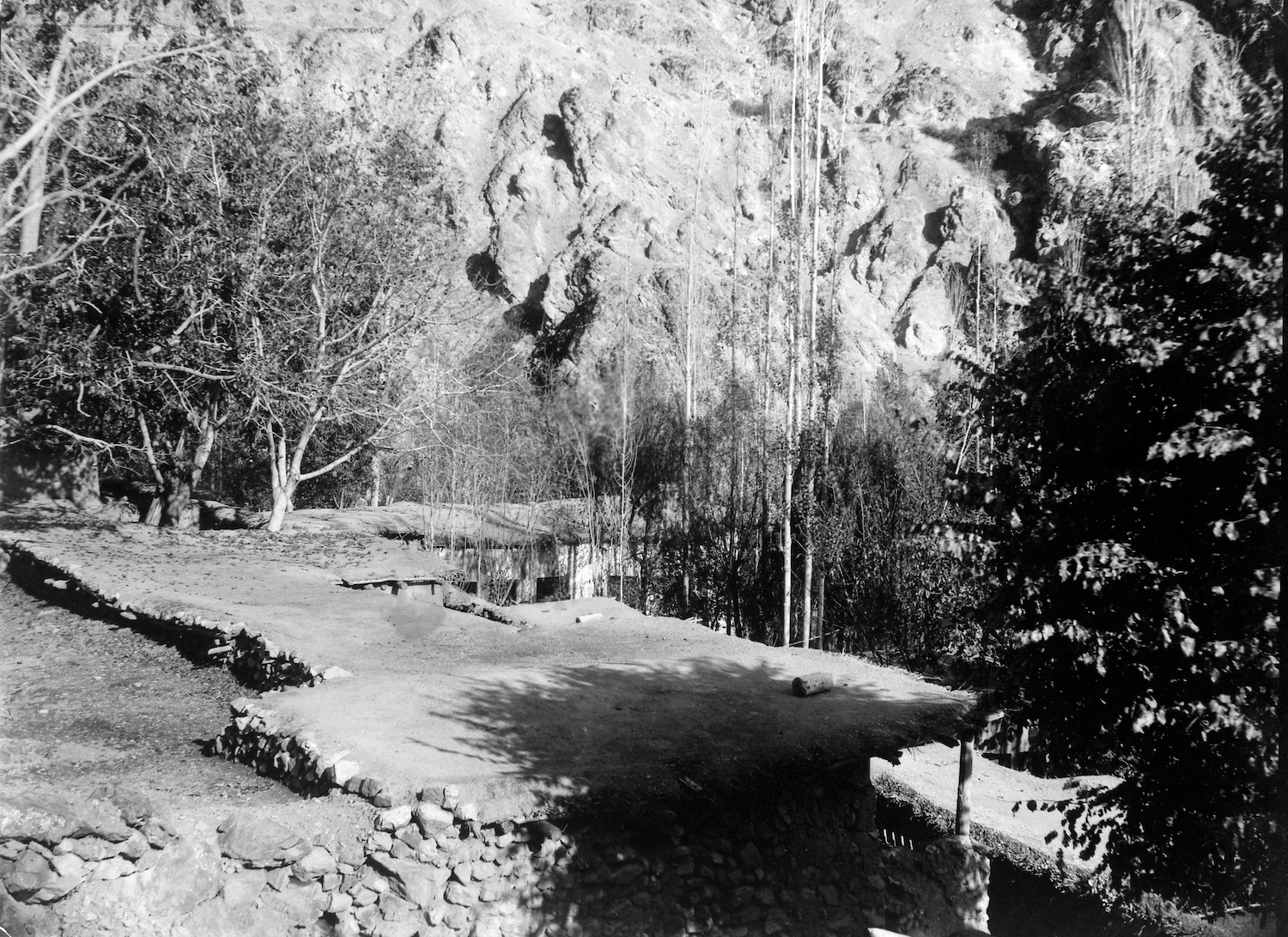
Murgh-Mahallih, Bahá’u’lláh's summer residence in Shimran, on the lower slopes of the Elburz Mountains, Iran, 1914. © Bahá'í International Community. Bahá'í Media Bank.
During the summer months, Bahá'u'lláh often traveled to Takúr, His ancestral village in Núr, Mázindarán, but sometimes, He would go to a beloved mountain retreat outside Ṭihrán, in Shimírán, called Murgh-Maḥallih, or "abode of the birds."
One year, Bahá'u'lláh spent the summer in Murgh-Maḥallih in a garden called "The Garden of Ḥájí Báqir." The house He lived in for that summer was three stories high, and overlooked a small lake. In the middle of the lake was a large bedrock platform circled by vegetation, in the center of which one could pitch a tent.
Six decades later, Murgh-Maḥallih was still in Bahá'u'lláh’s heart, as He compared a spot on Mount Carmel where He would pitch His tent, to His childhood retreat of the "abode of the birds." (See the last section of Part III of The Extraordinary Life of 'Abdu'l-Bahá.)
'Alí -Akbar Furútan, Memories of Bahá'u'lláh, page 5.
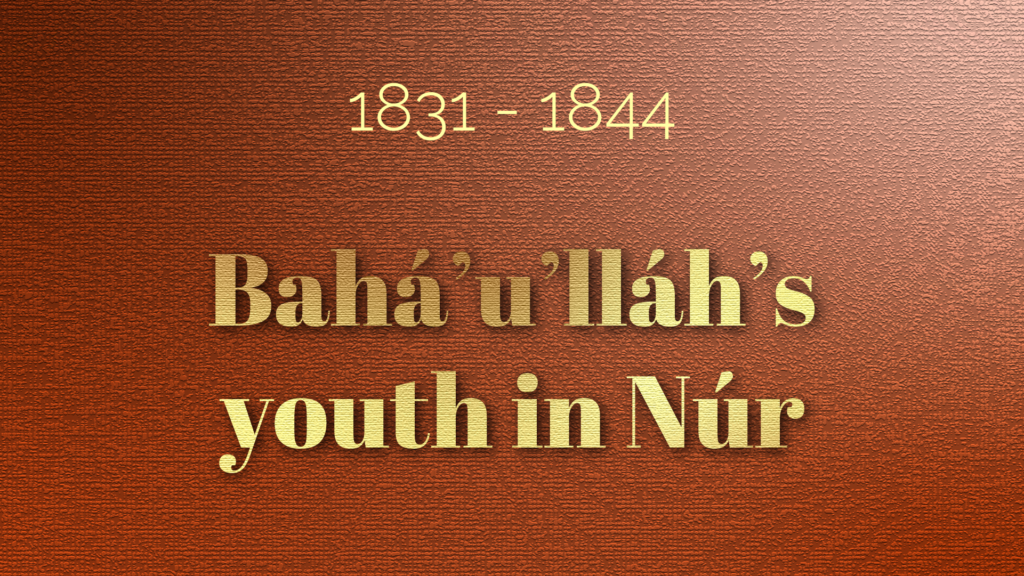
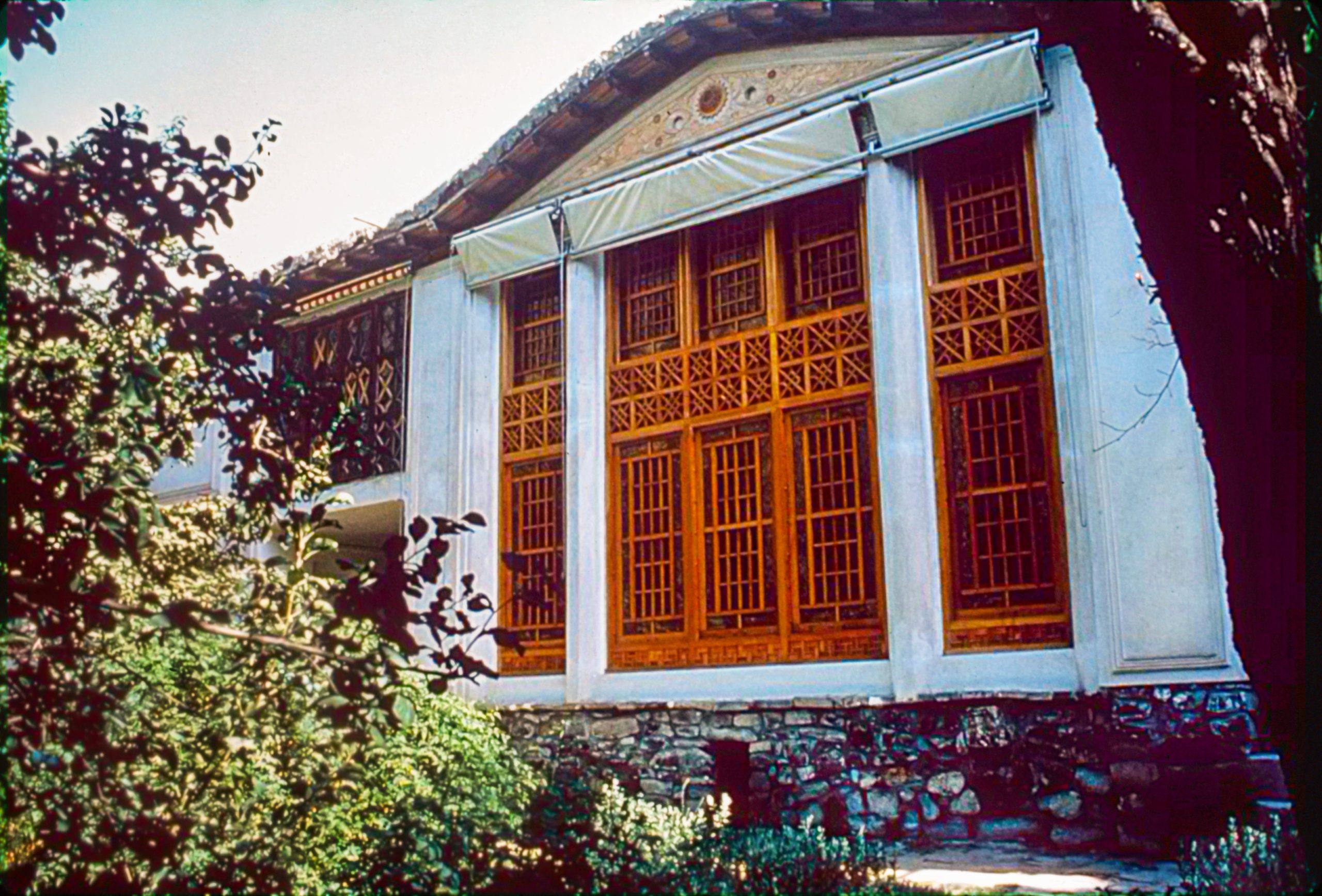
The house of Bahá’u’lláh in Takur, Mázandarán, destroyed by the government in 1981, September 1975. © Bahá'í International Community. Bahá'í Media Bank.
Bahá'u'lláh's father and their ancestors were originally from Takúr, in the district of Núr, within the province of Mazindárán. Mírzá Buzurg had a palatial house built in Takúr, and Bahá'u'lláh always spent part of the year, in the spring or summer months, in His family’s village. In winter months, the family retired to Dárkalá, also in Mázindarán, but near the Caspian Sea, with a much milder climate.
H.M. Balyuzi, Bahá'u'lláh: The King of Glory, page 21.
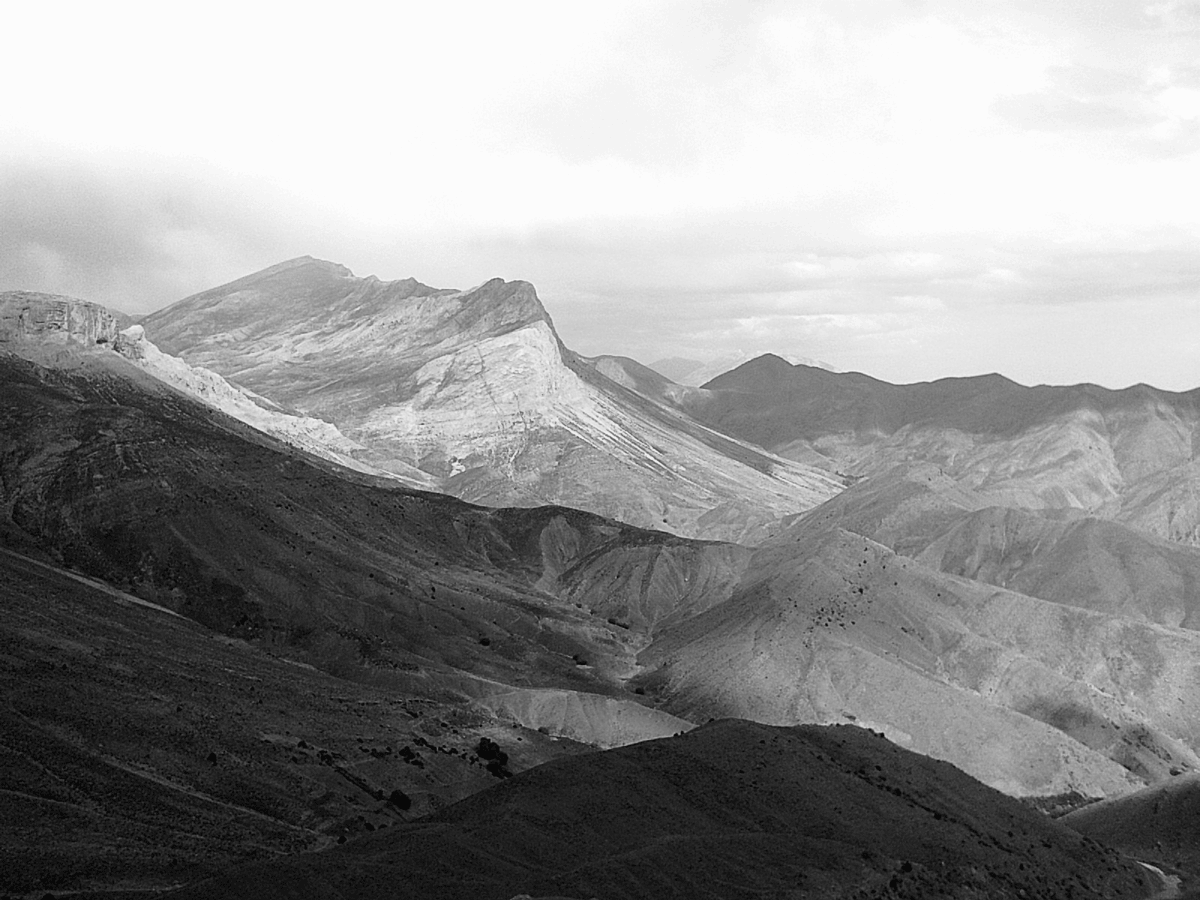
There are no high-quality photographs of Yálrúd, but this modern image is from Lar National Park, 12 kilometers south of Yálrúd, and its purpose is to convey the beauty of Bahá'u'lláh's native region, its verdure and rugged, mountainous terrain. 2008 Photograph by Alireza Javaheri. Wikimedia Commons.
In His youth, whenever Bahá'u'lláh traveled to Takúr, he usually stopped for a while in the nearby village of Yálrúd to visit the celebrated and famous Mujtahid, expert in Islámic law, Mírzá Muḥammad Taqíy-i-Núrí, a distant relative. One day, when Bahá'u'lláh arrived, Mírzá Muḥammad Taqíy-i-Núrí was lecturing 200 of his disciples and asked them to resolve a conundrum comparing Fáṭimih and the "daughter" of Mary, mother of Jesus. The students were unable to answer, but Bahá'u'lláh gave a brief and convincing explanation that the conundrum stated no woman could be compared to Fáṭimih, since Mary had never had a daughter.
Mírzá Muḥammad Taqíy-i-Núrí rebuked his disciples for not having been able to answer the question despite years of scholarly training, when Bahá'u'lláh, who had no academic training, had demonstrated his superiority over them.
Once Bahá'u'lláh had left, the venerated mujtahid told his students about two dreams he had about Bahá'u'lláh. Once, when Bahá'u'lláh was a child, he had dreamt that he, along with everyone else, was denied access to a house because the Qa'im of the house of Muḥammád was speaking with Mírzá Ḥusayn 'Alí of Núr (Bahá'u'lláh).
In his second dream, he had found himself in a room packed with trunks, each filled with books, and each word and every letter in these books was bejeweled. The mujtahid was so dazzled by the radiance of the books and overpowered by their brilliance, that he awoke.
This same family member was chosen by Mírzá Buzurg as the executor and trustee of His will.
Nabíl, The Dawn-Breakers, Chapter V: Bahá'u'lláh's Journey to Mazindárán
H.M. Balyuzi, Bahá'u'lláh: The King of Glory, pages 21-22.
H.M. Balyuzi, Bahá'u'lláh: The King of Glory, Appendix V, page 478 (for the mujtahid as executor and trustee of Mírzá Buzurg's will).
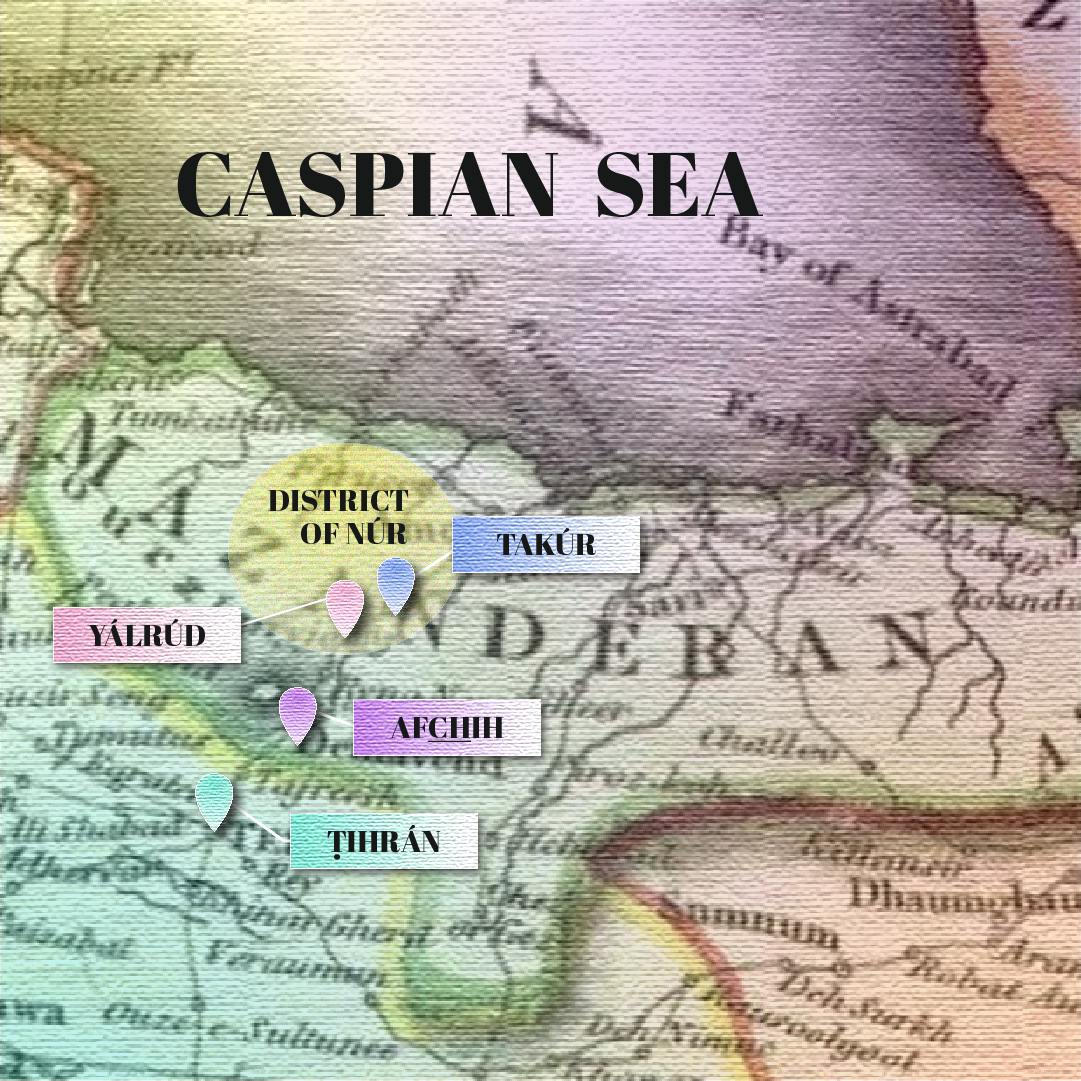
If a young Bahá'u'lláh rode for two days on horseback to Ṭihrán, He was most probably in the district of Núr at the time of the incidents. Here is a map of a few of the places associated with Bahá'u'lláh and His father, Mírzá Buzurg in the early part of His life, showing the villages of Afchih, Yárúld, and Takúr in Núr, in the province of Mázindarán. Original map: 1814 Thomson map of Persia during the Qajar dynasty. Wikimedia Commons.© Violetta Zein.
In His early teens, Bahá'u'lláh witnessed three separate occasions when a particularly cruel and unjust government tax-collector accosted His father, Mírzá Buzurg, demanding the payment of taxes. Unable to stand the injustice, Bahá'u'lláh rode His horse for two days until He arrived in Ṭihrán where He sought the dismissal of the tyrannical tax-collector, and having obtained the necessary papers for his dismissal, He returned to His parents.
'Alí Akbar Furutan, Stories of Baha’u’llah, pages 2-3.
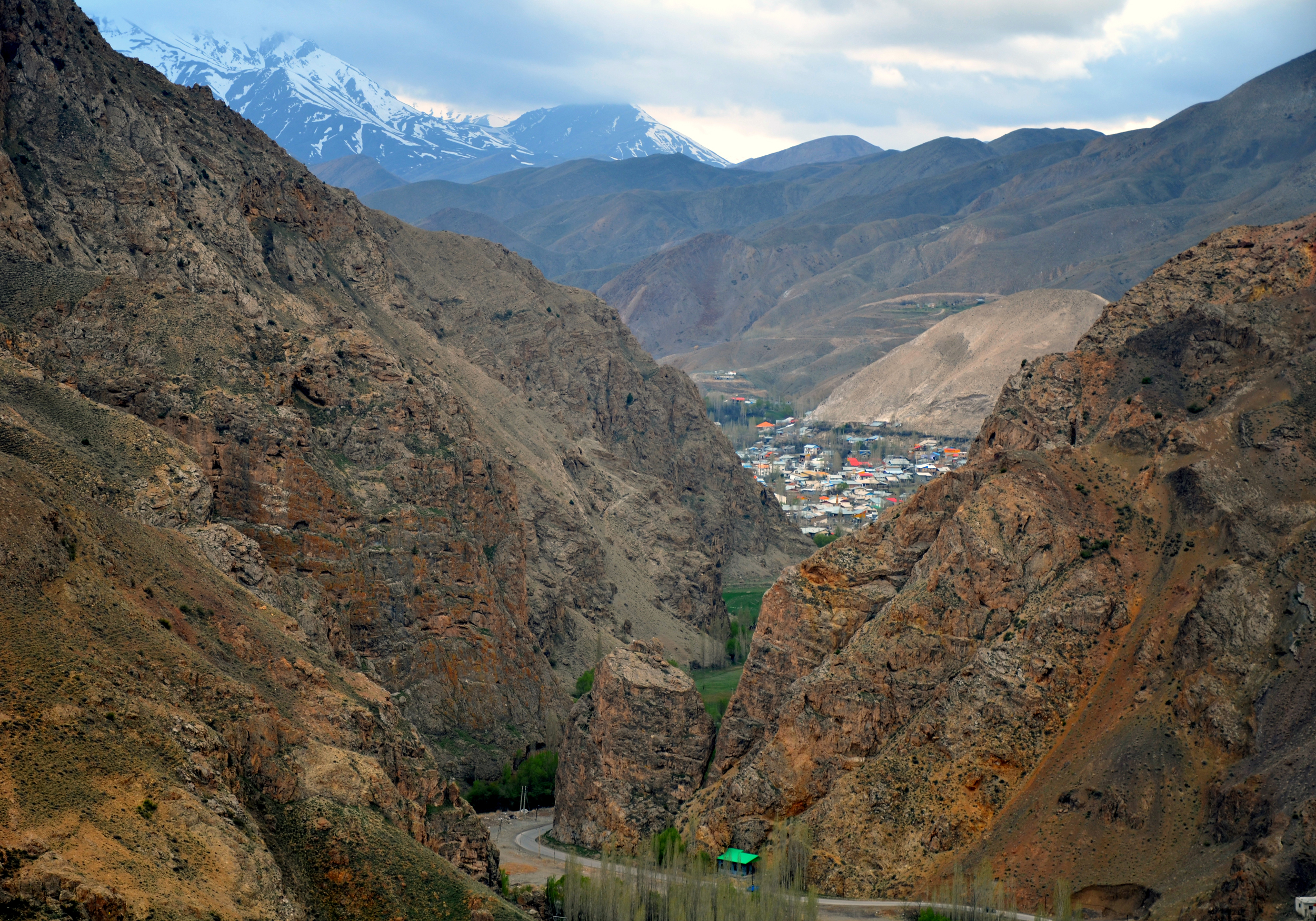
Modern view of the environs of Yálrúd. This is the village of Baladeh, about six kilometers north-west. 2013 photograph by Alireza Javaheri. Wikimedia Commons.
Throughout Bahá'u'lláh’s youth, He would often stop in Yalrúd on His way to Takúr to visit His mujtahid relative. But there was another noteworthy inhabitant of Yálrúd, who would have a great impact on Bahá'u'lláh’s life.
Yalrúd was the village where Ásíyih Khánum, Bahá'u'lláh's future wife, was born and raised. She was the daughter of Mírzá 'Isma'íl of Yálrúd, and was only a few years younger than Bahá'u'lláh. Although there may have been opportunities for them to encounter each other in Yalrúd, we have no record of them meeting prior to their wedding.
Baharieh Rouhani Ma'ani, 'Ásíyih Khánum: The Most Exalted Leaf Entitled Navváb, page 13.
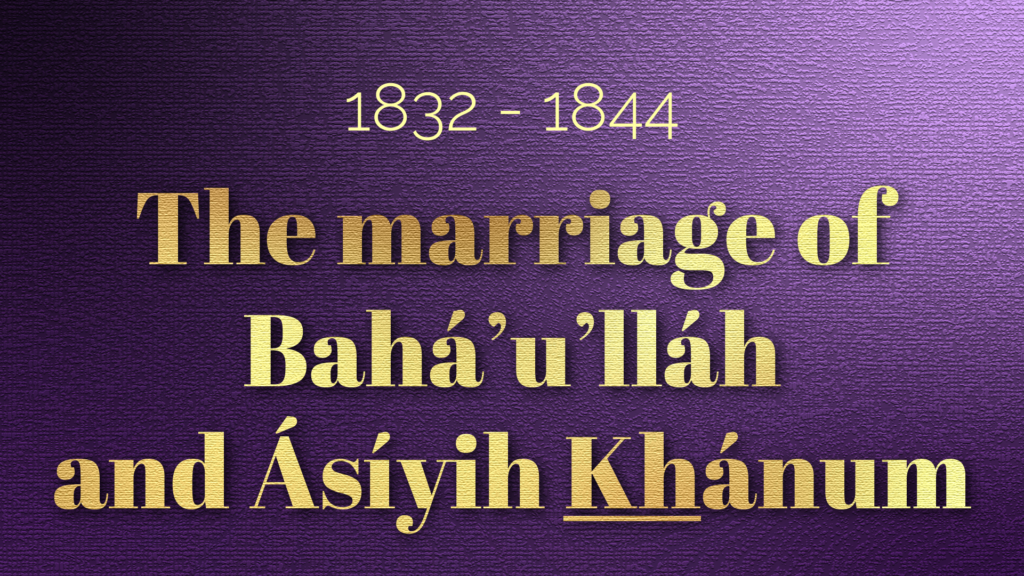
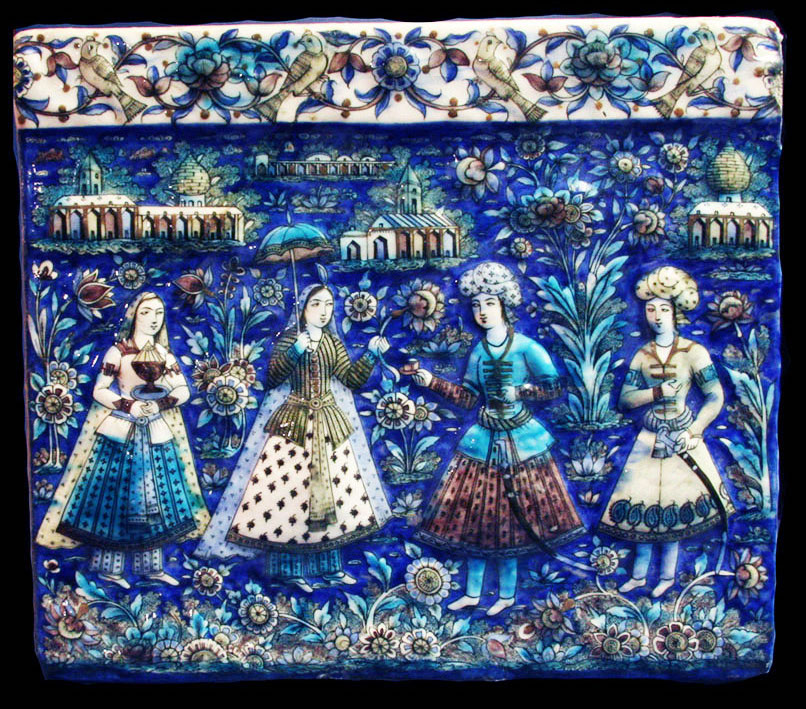
19th century Persian wedding scene portrayed in a Qajar Persian pottery tile. Source: Anavian Gallery, used with permission.
In 1832, when Bahá'u'lláh was 15 years old, Bahá'u'lláh's sister, Sáríh Khánum, married Mírzá Maḥmúd. This marriage united two prominent, wealthy and renowned families of Núr: the family of Mírzá Buzurg of Takúr, and the family of Mírzá Ismá'íl-i-Vazír of Yálrúd, and locals, described the union of these two great families as “adding wealth to wealth."
Mírzá Maḥmúd of Yalrúd had a sister, named Ásíyih Khánum, who was charming, vivacious, exceedingly beautiful, and displayed extraordinary spiritual attributes and perfections.
As soon as Bahá'u'lláh turned 18 and Ásíyih Khánum had come of age, Bahá'u'lláh's sister, Sáríh Khánum arranged a match made in heaven, asking her father to secure her hand. She requested that her father, Mírzá Buzurg, ask her sister-in-law, Ásíyih Khánum’s hand in marriage for her younger brother, Mírzá Ḥusayn 'Alí, Bahá'u'lláh.
Baharieh Rouhani Ma'ani, 'Ásíyih Khánum: The Most Exalted Leaf Entitled Navváb, pages 12-13.
Bahíyyih Khánum, the daughter of Bahá'u'lláh, quoted by Lady Blomfield in The Chosen Highway, page 39.
H.M. Balyuzi, Bahá'u'lláh: The King of Glory, page 23.
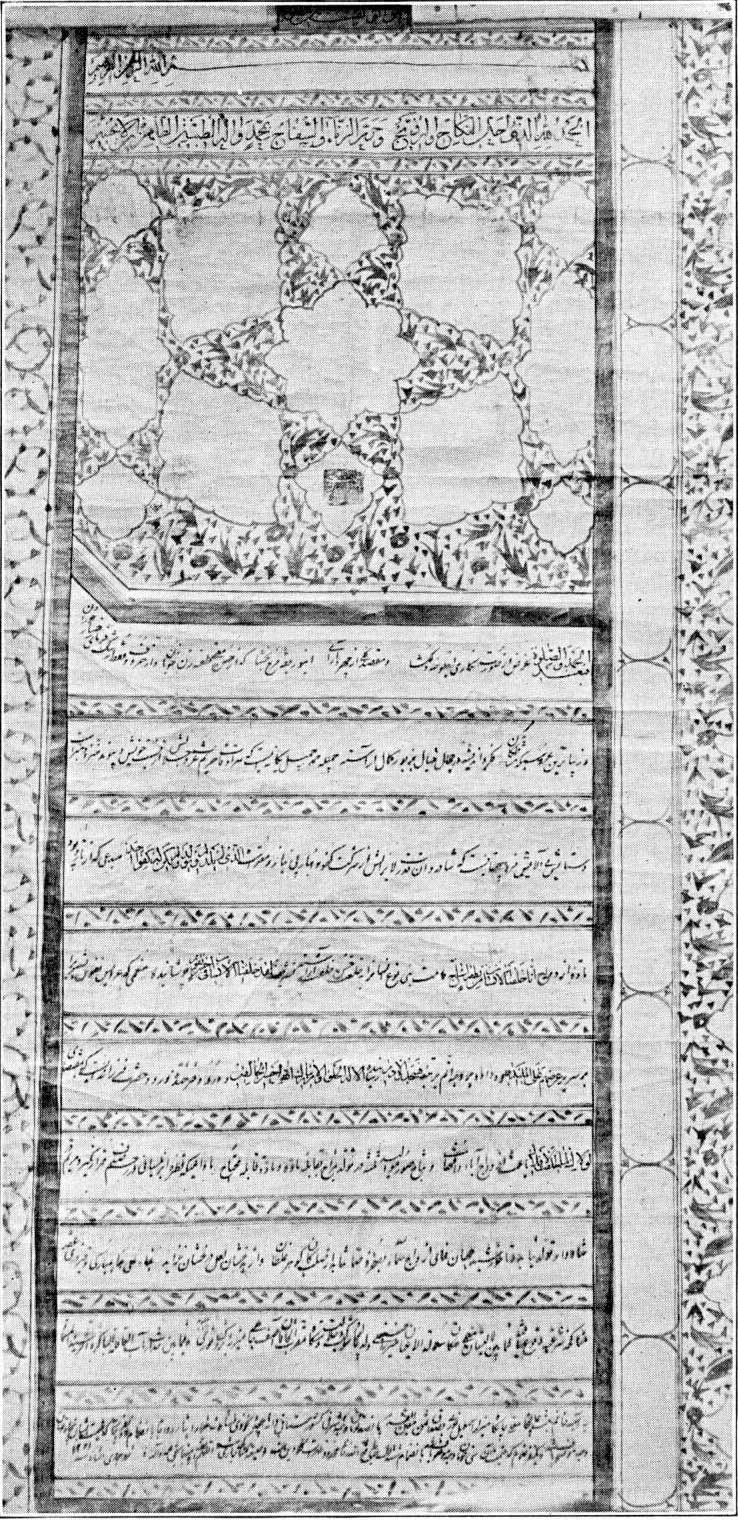
A facsimile of the original 1835 marriage certificate for Bahá'u'lláh and 'Ásíyih Khánum, originally published in The Bahá'í World Vol. 5 (1932-1934), pages 53, 63. Bahá'í Library Online.
The marriage certificate of Bahá'u'lláh and Ásíyih Khanum provides a great deal of information. It attests to Ásíyih Khánum’s perfections of character and specifies the considerable dowry, which included two maidservants, one servant, a large sum of money, and an important piece of property.
Ásíyih Khanum's daughter, the Greatest Holy Leaf tells us it took six months for a jeweler, working in her family's home, to craft the jewelry for the wedding. The very buttons of her garments were made of gold inlaid with precious stones. Her wedding treasures were so extensive that 40 mules were needed to carry her possessions to Bahá'u'lláh's home.
Bahíyyih Khánum, the daughter of Bahá'u'lláh, quoted by Lady Blomfield in The Chosen Highway
Baharieh Rouhani Ma'ani, 'Ásíyih Khánum: The Most Exalted Leaf Entitled Navváb.
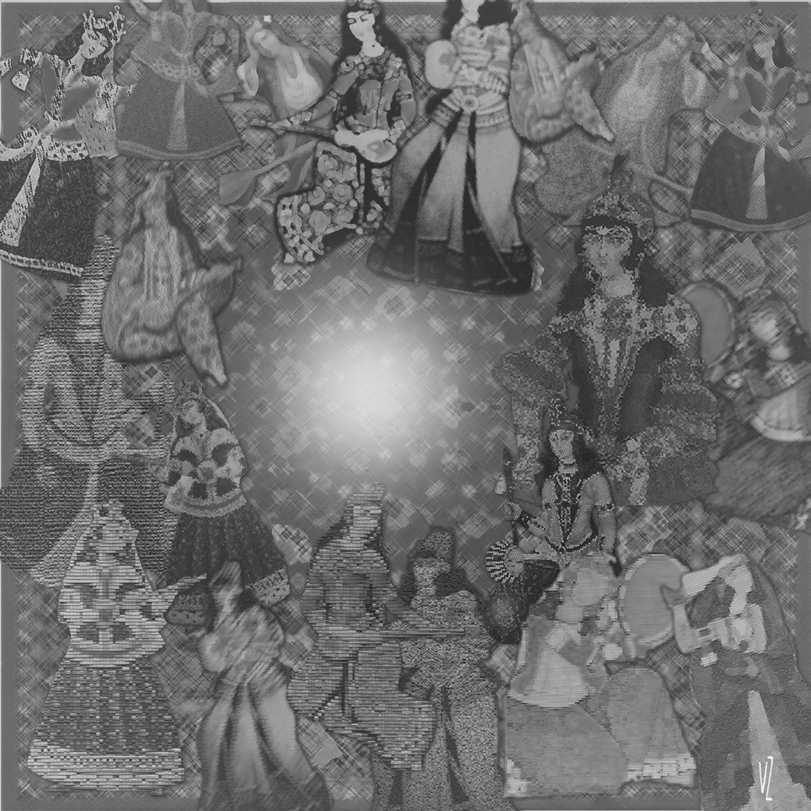
Abstract illustration of Ásíyih Khánum, a pearl among her contemporaries, which are cut out and digitally processed figures from Persian miniatures of the 19th century. © Violetta Zein.
Ásíyih Khánum was a tall, slender, graceful young woman with dark blue eyes, described by her daughter, the Greatest Holy Leaf, as "a pearl, a flower amongst women." Ásíyih Khánum was remarkably wise and intelligent and had the bearing and loveliness of a queen. Her character was extraordinary, and wherever she went, her presence created a penetrating atmosphere of love, happiness, and gentle courtesy. She was full of consideration for everyone, gentle, remarkably unselfish, and displayed in her every act the loving-kindness of her pure heart.
Ásíyih Khánum was infinitely more than a saintly young woman with a stainless character. She possesses a lofty station in the history of religion. Ásíyih Khánum is the manifestation of a 2,500-year old Biblical prophecy, and 'Abdu'l-Bahá confirmed that the Book of Isaiah, Chapter 54, verses 2 to 5, speak about Ásíyih Khánum and her marriage to Bahá'u'lláh:
"Enlarge the place of thy tent, and let them stretch forth the curtains of thine habitations: spare not, lengthen thy cords, and strengthen thy stakes; For thou shalt break forth on the right hand and on the left; and thy seed shall inherit the Gentiles, and make the desolate cities to be inhabited...For thy Maker is thine husband; the LORD of hosts is his name; and thy Redeemer the Holy One of Israel; The God of the whole earth shall he be called."
Lady Blomfield, The Chosen Highway
The Bible, King James version, Isaiah 54:2-5
Baharieh Rouhani Ma'ani, 'Ásíyih Khánum: The Most Exalted Leaf Entitled Navváb, pages 59-61 for 'Abdu'l-Bahá's detailed and heart-rending confirmation regarding the prophecy in Isaiah.
‘Call to Remembrance’, by Geoffry Marks, ‘Bahá'u'lláh – A Short Biography’, by Moojan Momen
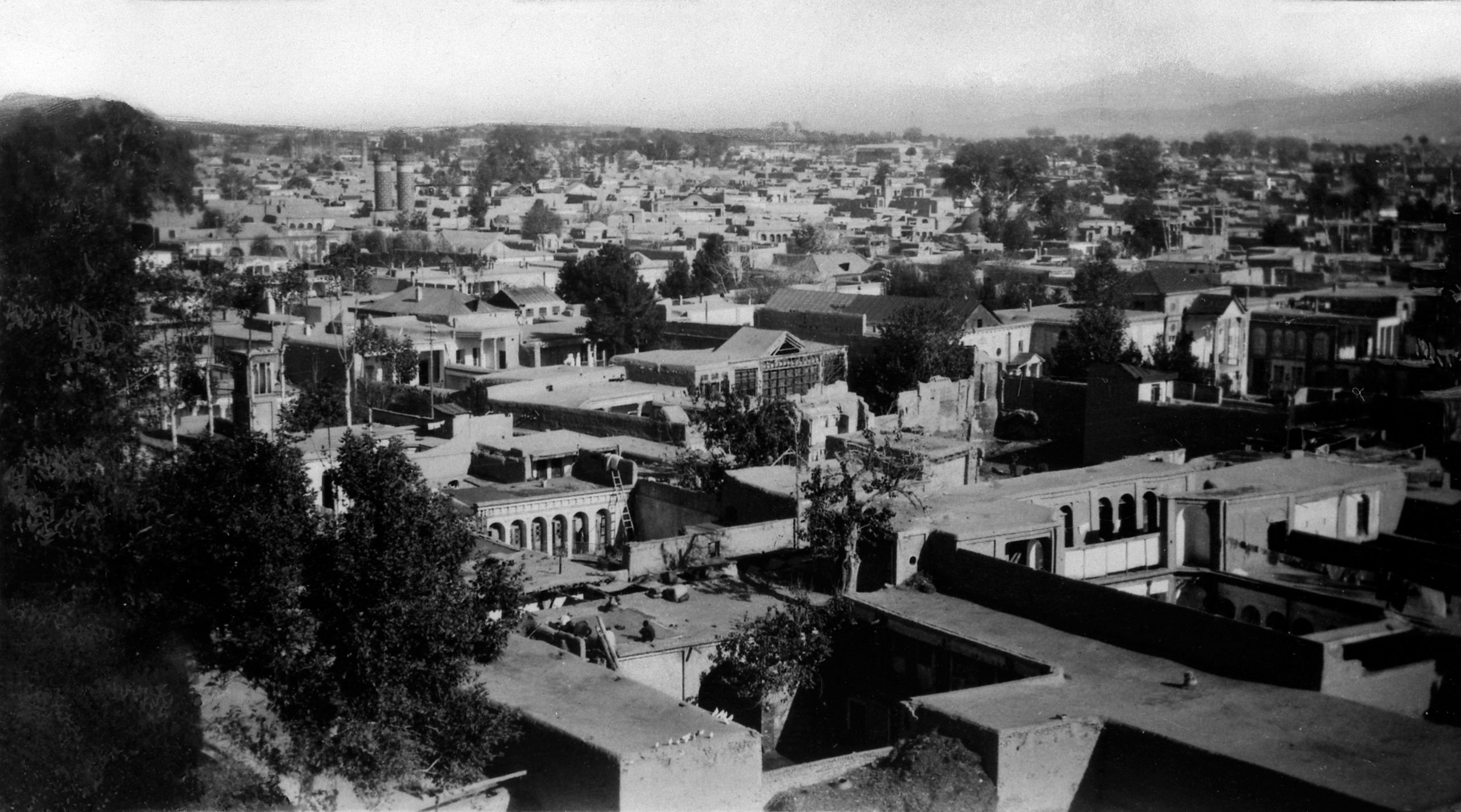
The city of Ṭihrán, Iran, where Bahá’u’lláh was born in 1817, where His first two children were born and died between 1839/40 and 1844, and where His third child, 'Abbás, later known as 'Abdu'l-Bahá, was born in 1844. This is also the city where much of Bahá'u'lláh and Ásíyih Khánum's charitable work takes place. Photograph c. 1930. © Bahá'í International Community. Bahá'í Media Bank.
Ásíyih Khánum was called by the title "Navvábih", the feminine form of an honorific title meaning "Highness" but the fact Ásíyih Khánum was given this title in early childhood clearly indicates that she emanated great nobility and graciousness from her earliest years. Bahá'u'lláh chose to address her with the masculine version of the title, Navváb, a mark of great respect.
In the early years of their married life Bahá'u'lláh and Ásíyih Khánum shared their time between Ṭihrán, Takúr, and Yálrúd. Traveling those 50-70 kilometers by mule was extremely arduous, so any journey to Núr would have resulted in a lengthy stay. Ásíyih Khánum and Bahá'u'lláh, as young people from very noble lineage, lived comfortable lives. It is believed their first two children were boys, born around 1839-1840, but, tragically, both died in infancy.
Bahá'u'lláh and Ásíyih Khánum were an exceptional couple and shunned all the activities most people of their rank and social position relished, such as state functions, social ceremonies, frivolous pastimes, and acquiring luxuries. Instead, they devoted themselves to charitable pursuits, an important component of their Muslim faith, and cared deeply for the poor and for all those who were unhappy or in trouble. No one was ever turned away from their home, and all newcomers were welcomed with kind hospitality.
Poor women constantly sought the company and counsel of Ásíyih Khánum. They poured their hearts out to her, telling their stories of woe, and found themselves comforted and consoled by her loving helpfulness. Bahá'u'lláh and Ásíyih Khánum's acts of service earned them the most wonderful names. They became widely known as "The Father of the Poor" and "The Mother of Consolation."
The University of Chicago's Digital Dictionaries of South Asia, Combined Persian Dictionaries Search: Definition of the word نواب (Navváb)
Baharieh Rouhani Ma'ani, Leaves of the Twin Divine Trees, pages 85-86.
Baharieh Rouhani Ma'ani, 'Ásíyih Khánum: The Most Exalted Leaf Entitled Navváb, pages 14-16.
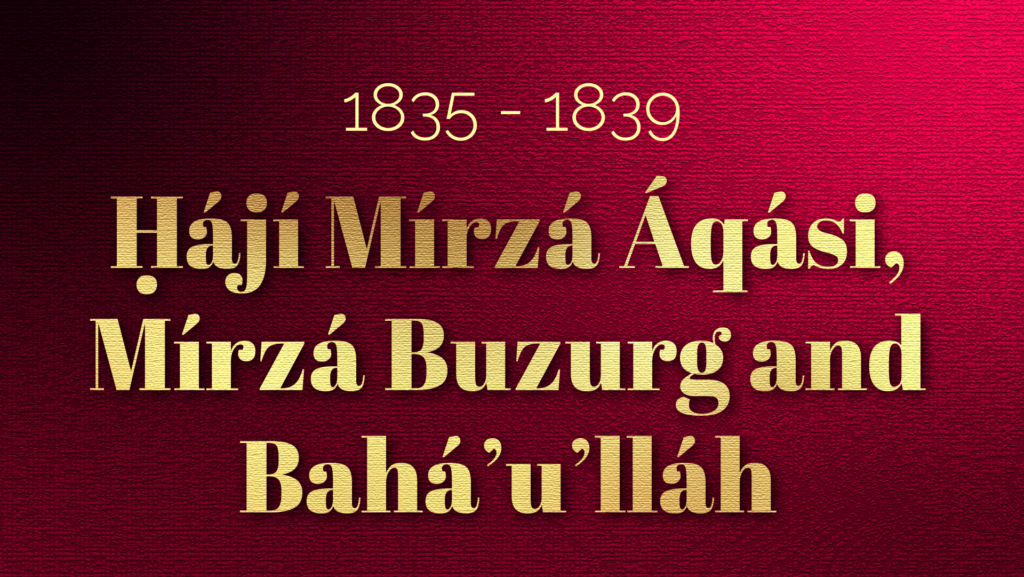
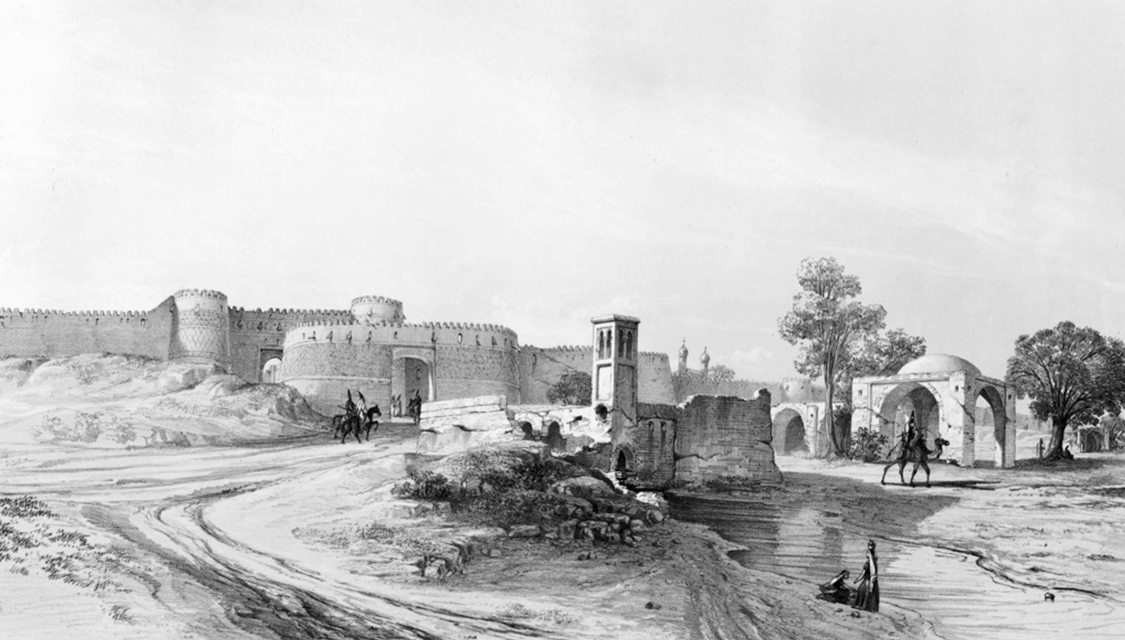
The Gate of Shimrán, in Ṭihrán, in the vicinity of the house Bahá'u'lláh rents for His entire family. 1851 engraving by Eugène Flandin from Voyage en Perse, avec Flandin. Wikimedia Commons.
Sometime in 1835, Ḥájí Mírzá Áqásí obtained a letter written by Mírzá Buzurg condemning him for the murder of a dear friend of his, a celebrated Qá’im-Maqám, and this provoked him to unleash the full force of his vengeance. In June 1835, he had Mírzá Buzurg dismissed from his governorships of Burújird and Luristán and canceled his annual allowance, the only revenue he had. Ḥájí Mírzá Áqásí also put pressure on Mírzá Buzurg’s last wife, Ḍiyá’u’s-Salṭánih, the daughter of Fatḥ-‘Alí Sháh, to divorce him.
In dire financial straits, Mírzá Buzurg was forced to sell and mortgage some of his properties. Once she obtained a divorce, Ḍiyá’u’s-Salṭánih’s terms were so exorbitant that Mírzá Buzurg could not pay them back, and she had him beaten and tortured until he sold everything he owned, including his palatial complex of houses in Ṭihrán, and all their expensive carpets and furnishings. Mírzá Buzurg moved into one of his wives’ houses for four years before retiring to ‘Iráq where he died in 1839, four years after Ḥájí Mírzá Áqásí had completely ruined him.
Sometime after October 1835, Bahá'u'lláh, then newly-married, rented a house close to His father, near the Gate of Shimrán, moving in with His wife Ásíyih Khánum, His mother, Khadíjih Khánum, and the rest of His stepmothers, brothers, and sisters. Bahá'u'lláh would spend the rest of His years in Ṭihrán in this house, where all His children were born.
Source: H.M. Balyuzi, Bahá'u'lláh - The King of Glory, pages 15-17.
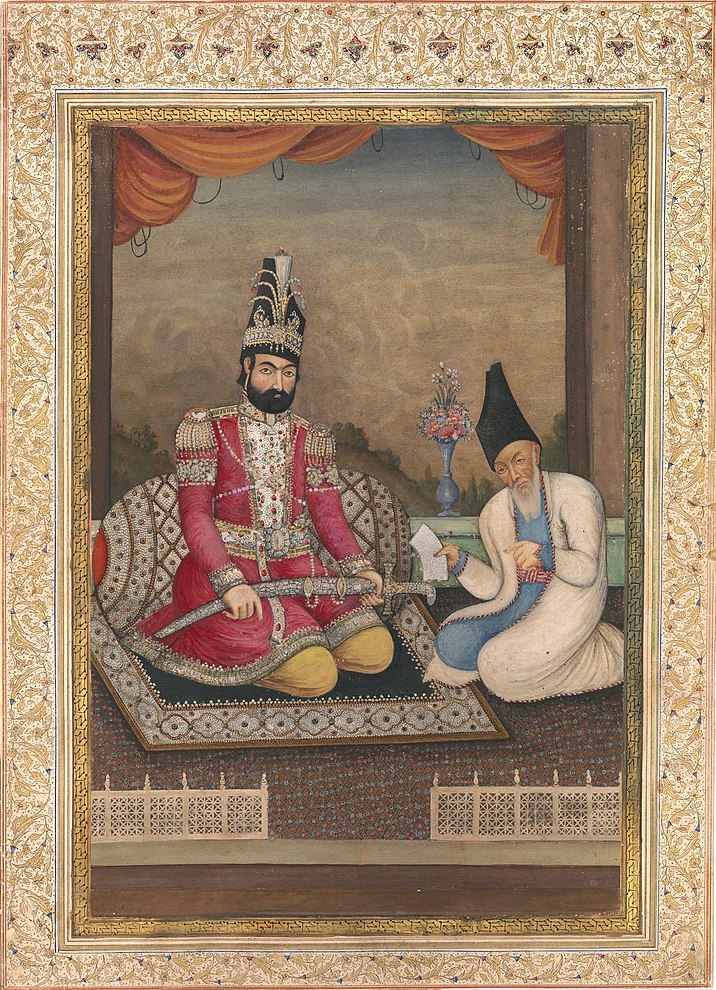
Ḥájí Mírzá Aqásí (In white, on the right) the Grand Vizier of Muḥammad Sháh (in red, on the left). Mid-nineteenth-century Persian Miniature from the New York Metropolitan Museum of Art collection. Wikimedia Commons.
Ḥájí Mírzá Áqásí was dubbed by Shoghi Effendi the "Antichrist of the Bábí Revelation," so bloodthirsty was his hatred of the Bábís. He was the Grand Vizir of Muḥammad Sháh and, though he considered Mírzá Buzurg his enemy, he respected Bahá’u’lláh, but was insincere. After Mírzá Buzurg's death in 1839, Ḥájí Mírzá Áqásí continued to outwardly show Bahá’u’lláh consideration, and visited Him in His home, addressing Him like a son.
One day, Ḥájí Mírzá Áqásí passed by a charming village belonging to Bahá'u'lláh called Quch-Hisar, and was completely won over by its beauty and abundant sources of water. He decided he wanted this village for himself. He summoned Bahá'u'lláh in order to purchase it, but Bahá'u'lláh told him He could not sell the village, because it did not belong exclusively to Him. He shared ownership of the village with a number of other people, rich and poor, adults and some still minors. Bahá'u'lláh suggested Ḥájí Mírzá Áqásí confer on the matter with the other owners, and obtain their consent.
When Ḥájí Mírzá Áqásí decided to try to acquire the village through fraudulent means, Bahá'u'lláh transferred His ownership to one of the Shah's sisters, who had also expressed interest in the charming place. Ḥájí Mírzá Áqásí contested the situation, but the Sháh ruled against him. Then, Ḥájí Mírzá Áqásí showed his true colors, and tried to discredit Bahá'u'lláh, who successfully established His innocence. In every attack the Grand Vizir ventured against Bahá'u'lláh, he came away defeated and humiliated.
Nabíl, The Dawn-Breakers, Chapter V: Bahá'u'lláh's Journey to Mazindárán, pages 120-122.
Shoghi Effendi, God Passes By, for the reference to the antichrist of the Bábí Revelation
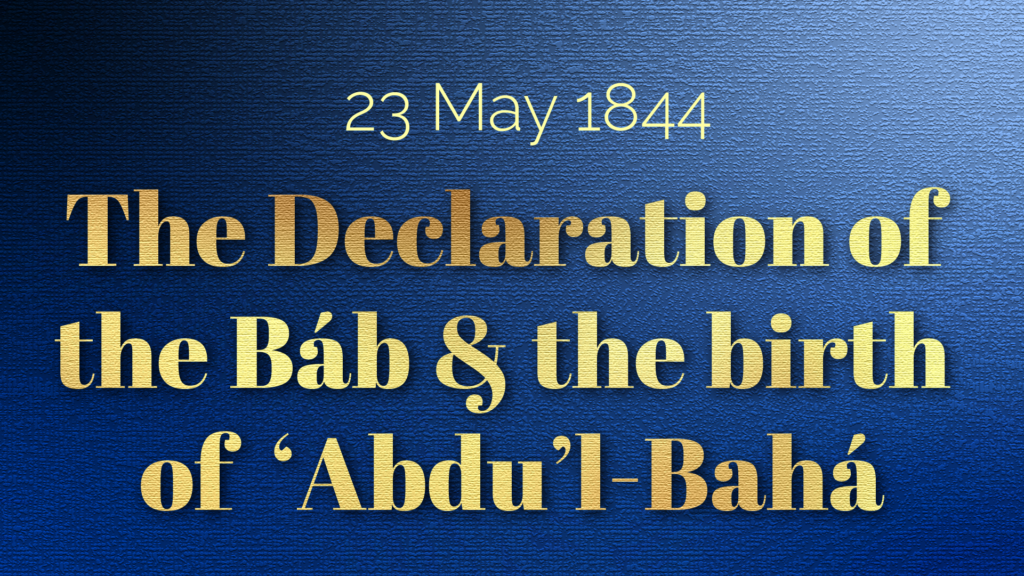
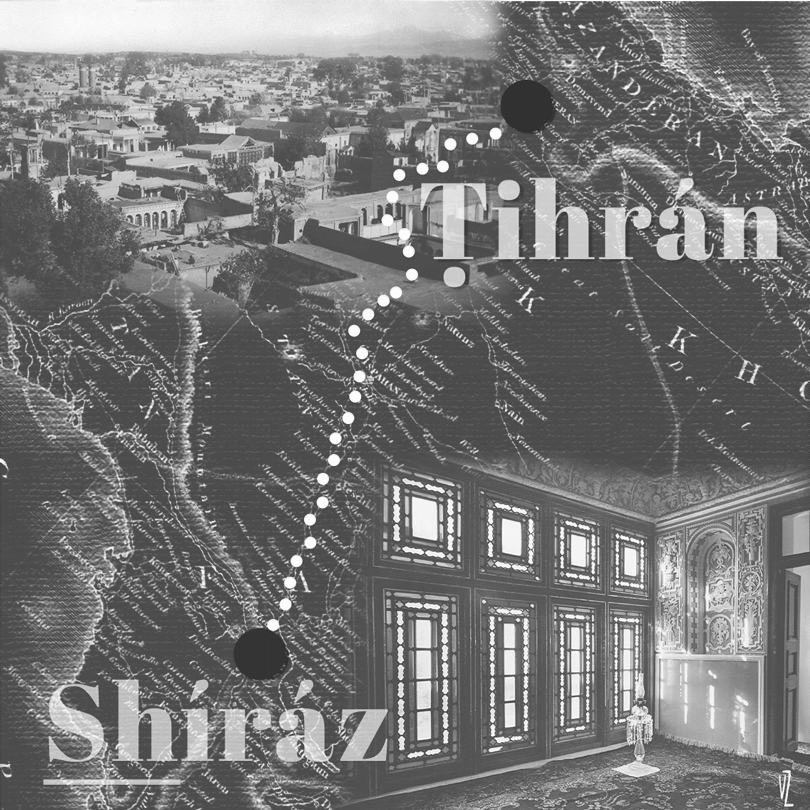
A spiritual map of the 700 kilometers (430 miles) separating Shíráz, to the south and Ṭihrán, to the North. In Shíráz, the Báb declared His Mission to Mullá Ḥusayn in the carpeted, stained-glass windowed room on the bottom right of the graphic. In Ṭihrán, ‘Abdu'l-Bahá was born in a house near Shimrán gate, symbolically represented by an early 20th century photograph of the city. © Violetta Zein.
The Bábí and Bahá'í Faiths are deeply intertwined. Following the 6,000 year Adamic Cycle, which ended with Muḥammad's Dispensation, the Báb’s Mission was to inaugurate a wholly new Dispensation in the progressive Revelation of the world's religions. The Báb's brief ministry prepared the way for the Dispensation of Bahá'u'lláh and also inaugurated the Bahá'í Cycle. The Báb and Bahá'u'lláh, the "Twin Manifestations of God," were born two years and a day apart, and their birthdays are celebrated as Twin Holy Days. During the Báb’s lifetime, they were in regular contact, and both suffered persecution, torture and multiple imprisonments. The Báb and Bahá'u'lláh are regarded by Bahá'ís as "Co-Founders" of the Bahá'í Faith.
Another deep connection uniting the Bábí and Bahá'í Faiths is that on the day the Bábí Faith was born, inaugurating the Bahá'í Dispensation, so was 'Abdu'l-Bahá born, He Who was destined by God to be the Perfect Exemplar, and the very personification in His spiritual qualities, His character, and His every action, of all the teachings of Bahá'u'lláh, the Manifestation of God for today.
These two events took place approximately six hours apart, in Shíráz, in the south of Persia, and 700 kilometers (430 miles) to the north, in Ṭihrán. This is the story of that momentous night.
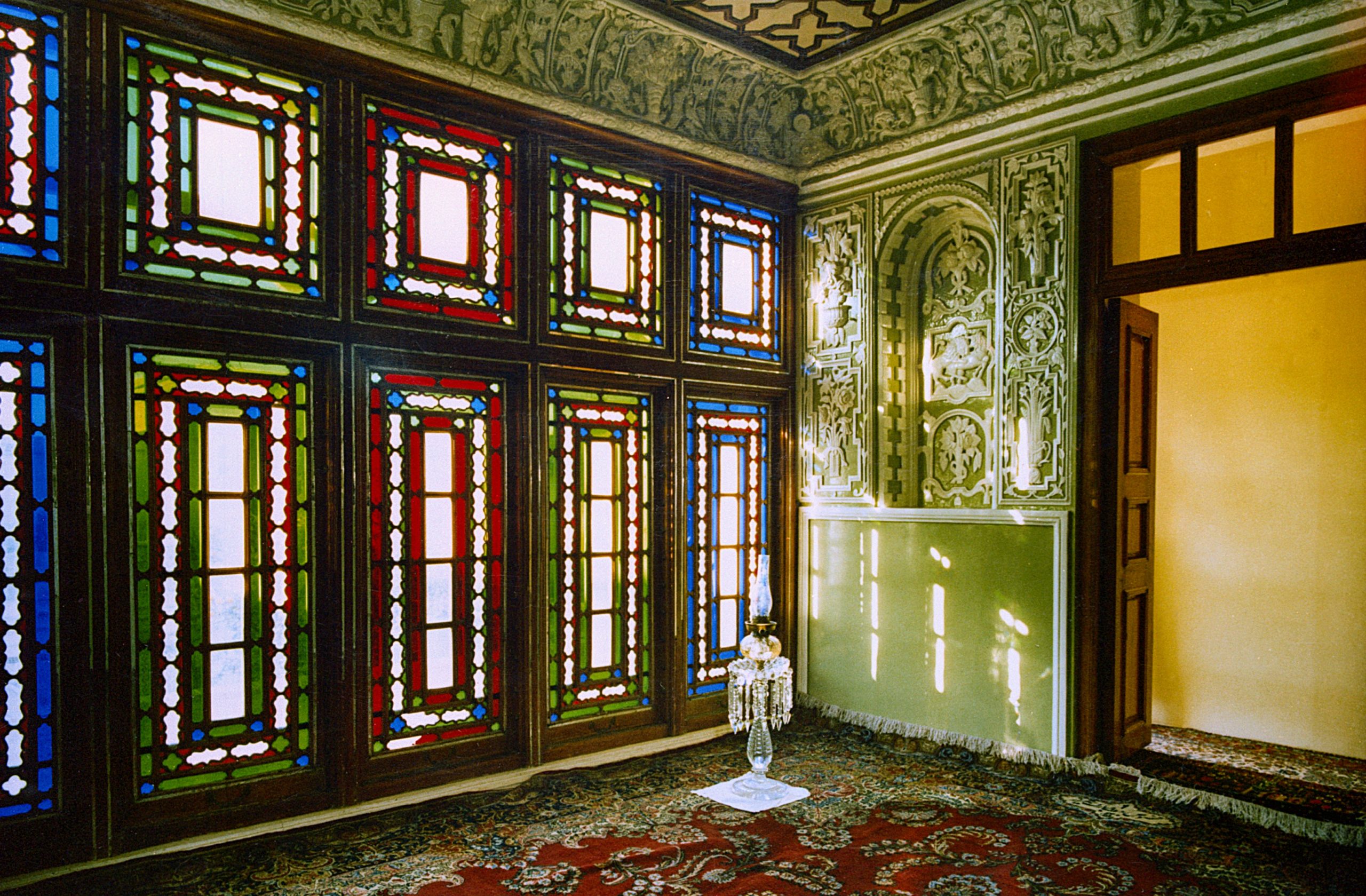
The room in the House of the Báb where the Báb declared His Mission in Shíráz, Iran, before its destruction in 1979. © Copyright Bahá'í International Community. Bahá'í Media Bank.
An hour before sunset on 22 May 1844, the Báb, born Siyyid ʻAlí Muḥammad Shírází, a 25-year-old descendent of the Prophet Muḥammád, of pure and holy lineage, announced He was the Qá'im, the Promised One of Islám, to the young Mullá Ḥusayn, the first to believe in Him. In his own words, Mullá Ḥusayn testifies to that night:
“I sat spellbound by His utterance, oblivious of time and of those who awaited me...I was enthralled by the music of that voice which rose and fell as He chanted; now swelling forth as He revealed verses of the Qayyúmu’l-Asmá’, again acquiring ethereal, subtle harmonies as He uttered the prayers He was revealing."
The Revelation the Báb had the effect of a thunderbolt on Mullá Ḥusayn, who felt transfigured to the very depth of his soul by its dazzling splendor and overwhelming power. This instant spiritual transformation was the effect the Báb would have on countless of His early followers.
Shoghi Effendi, God Passes By.
23 May 1844 as the birth of both the Bábí and Bahá'í religions, see Shoghi Effendi, God Passes By (Foreword, first sentence) and Bahá'í World News Service: Bahá'ís Observe Declaration of the Báb, 19 May 2009.
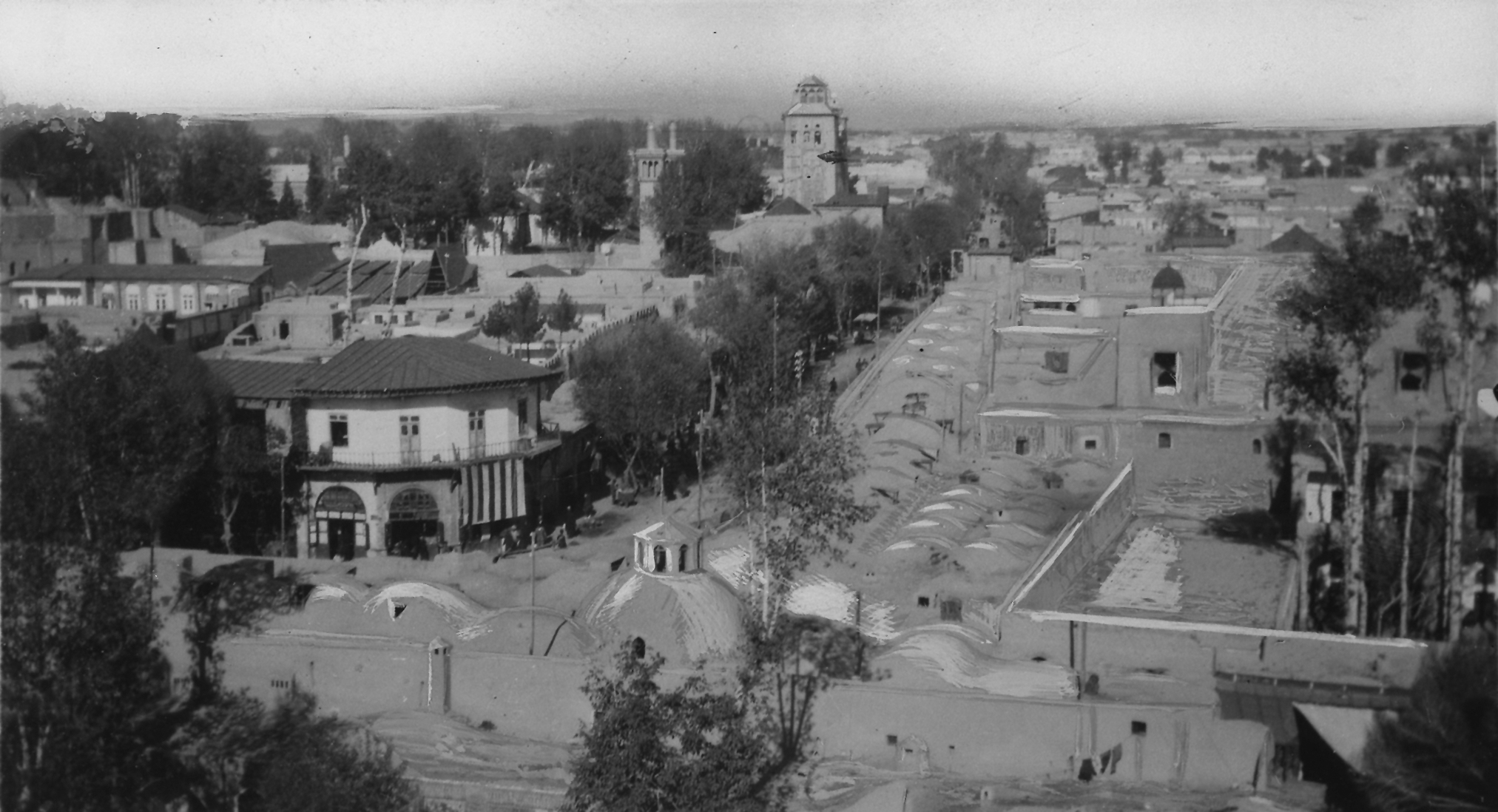
A 1930 panorama of the city of Ṭihrán, in Persia, a city which saw the births of Bahá’u’lláh, 'Abdu'l-Bahá, His eldest son, and His daughter Bahíyyih Khánum and son Mírzá Miḥdi. This city is also where were born and died three more of Bahá'u'lláh and Navváb's children. © Bahá'í International Community. Bahá'í Media Bank.
Seven hundred kilometers away in Ṭihrán, and six hours into the enthralling, momentous encounter between the Báb and Mullá Ḥusayn, Bahá'u'lláh and Ásíyih Khánum welcomed their Son 'Abbás (Lion), into the world. He would later adopt the title 'Abdu'l-Bahá, meaning Servant of Bahá.
It is a cherished miracle for Bahá'ís, that on the day the Bahá'í Dispensation was inaugurated, God ordained for its Perfect Exemplar, 'Abdu'l-Bahá to be born, only a few hours later. And for Him to be born as the Son of Bahá'u'lláh, “Him Whom God shall make manifest,” for Whom the Báb was to prepare the way.
For 'Abdu'l-Bahá intuitively recognizing the station of Bahá'u'lláh: H.M. Balyuzi, The Covenant of Bahá'u'lláh, Chapter 2.
For 'Abdu'l-Bahá being the third child: Baharieh Rouhani Ma'ani, 'Ásíyih Khánum: The Most Exalted Leaf Entitled Navváb, page 17.
For the titles of Bahá'u'lláh: Shoghi Effendi, The World Order of Bahá'u'lláh, The Dispensation of Bahá'u'lláh: 'Abdu'l-Bahá.
For the quote about "the seal of God:" Rúhíyyih Rabbani, The Priceless Pearl, Chapter 1.
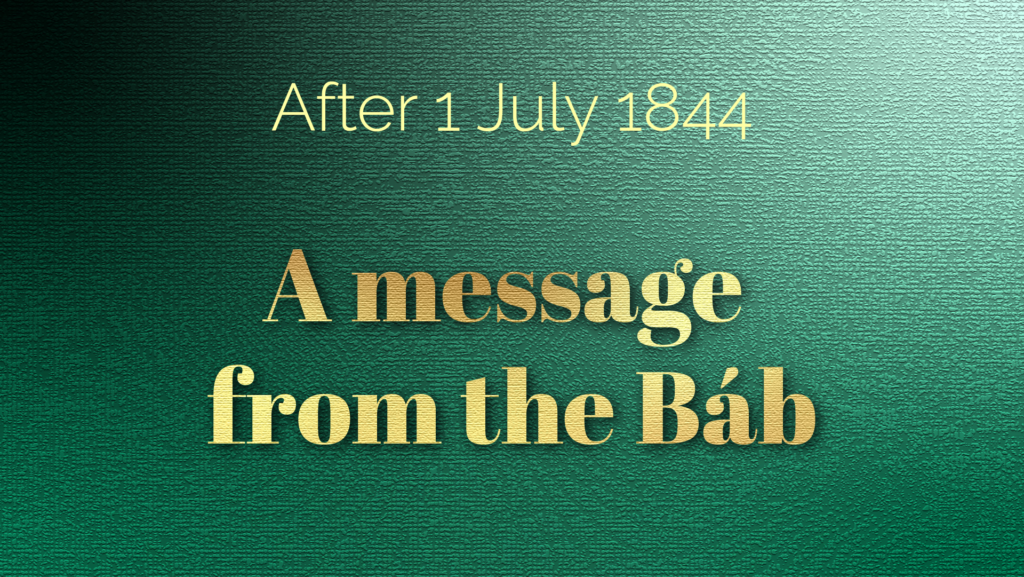
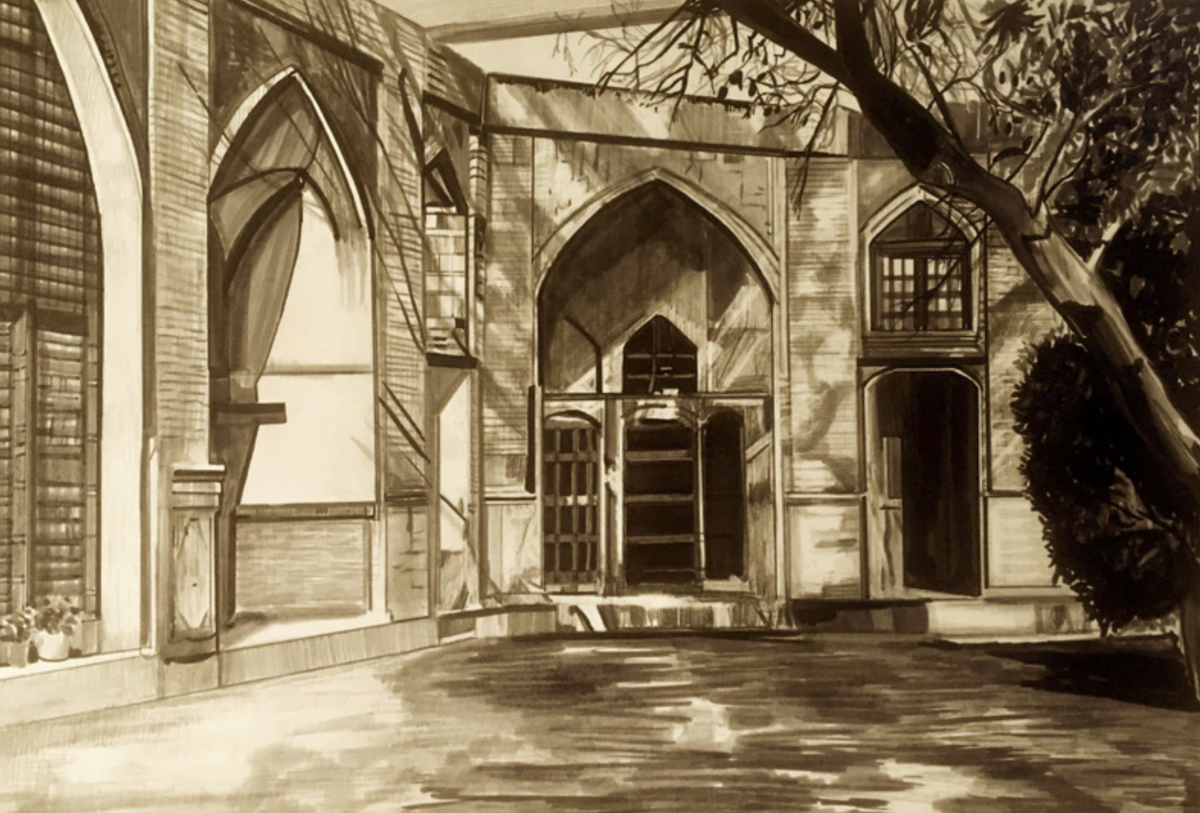
Lacking an illustration for the theological school where Mullá Ḥusayn stayed, this is a drawing of the theological seminary where Bahá'u'lláh stayed in Ṭihrán, called the Madrisiy-i-Ṣadr. Illustration from Julio Savi, A Most Dramatic Chapter in the Spiritual History of Humankind: A Pictorial Essay, published in Bahá'í World 2020-05. Bahá'í Library Online.
Around 1 July 1844, about 40 days after His Declaration to Mullá Ḥusayn, 17 of the 18 Letters of the Living, the first Bábís, had recognized the Báb's station and embraced His Cause, in person, in dreams or by letter. The Báb delivered a stirring address before parting with the Letters of the Living, urging caution, unveiling their rank, and hinting at an even more glorious Day.
The Báb then entrusted Mullá Ḥusayn, the First Letter of the Living with a crucial mission: to travel to Ṭihrán and find the secret “hidden in that city,” which, “when made manifest, it shall turn the earth into paradise.”
The Báb had specifically told Mullá Ḥusayn to travel through Iṣfahán, Káshán and Qum. Once he had arrived in Ṭihrán, Mullá Ḥusayn rented a room in the theological seminary known as the madrisih of Páy-i-Minár, not far from Bahá'u'lláh’s house. Each day, he would leave early in the morning and return after sunset, never leaving his room at night. After overhearing Mullá Ḥusayn speak to a divine, a man named Mullá Muḥammad-i-Mu’allim of Núr was drawn to him because of his passion and eloquence.
Around midnight, Mullá Muḥammad-i-Mu’allim called on Mullá Ḥusayn who not only welcomed his visitor with affection and courtesy but felt that this encounter was the reason for his stay in the seminary. As soon as he discovered Mullá Muḥammad-i-Mu’allim was from Núr, Mullá Ḥusayn asked pointed questions about the character and occupation of any outstanding member of the late Mírzá Buzurg’s family. He instantly knew he had found the “secret” hidden in Ṭihrán, and asked him to deliver a package to Bahá'u'lláh and return with His response. At dawn, Mullá Muḥammad-i-Mu’allim set out to deliver the message from the Báb.
Shoghi Effendi, God Passes By.
Nabíl, The Dawn-Breakers, pages 86 and 97-106.
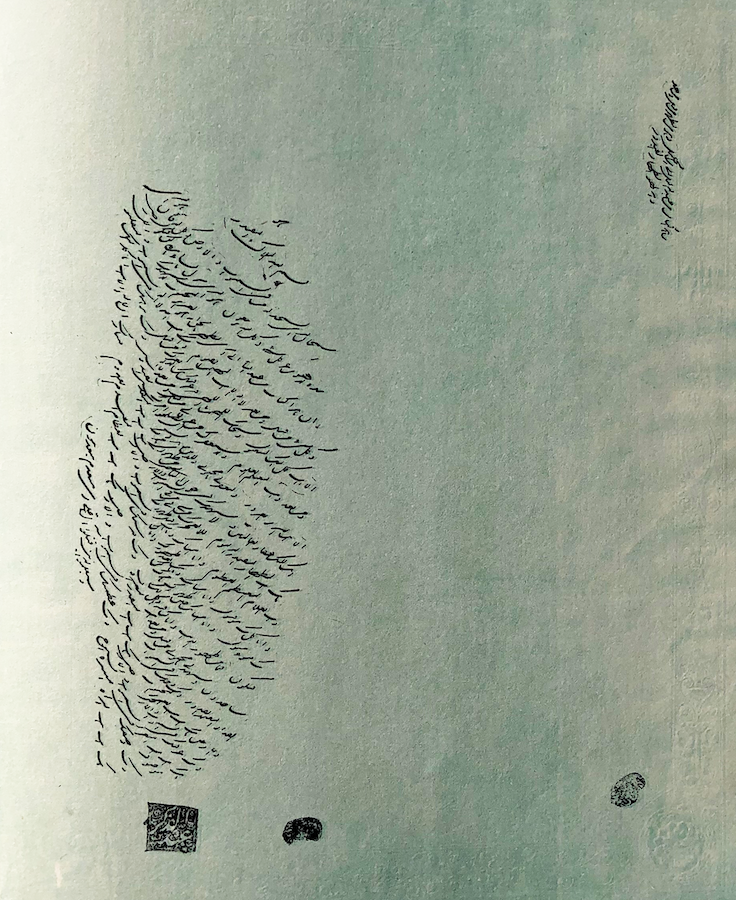
Facsimile of the Báb's Tablet addressed to "Him who will be made manifest" (Bahá'u'lláh). There is no official confirmation that this Tablet is in fact the same scroll which Mullá Ḥusayn entrusted to Mullá Muhammad-i-Mu’allim. Nabil, The Dawn-Breakers.
As Mullá Muḥammad-i-Mu’allim was approaching Bahá’u’lláh’s house, he recognized His younger brother. Mírzá Músá, standing by the gate, and conveyed Mullá Ḥusayn’s message. Mírzá Músá returned a few moments later, welcoming him in. Mullá Muḥammad offered Mírzá Músá the scroll from the Báb and Mírzá Músá laid it before Bahá'u'lláh, who invited both men to sit.
Bahá'u'lláh unfolded the scroll, glanced at its content and began to melodiously read aloud certain passages. After reading a page of the scroll, Bahá'u'lláh turned to Mírzá Músá, and said:
"Músá, what have you to say? Verily I say, whoso believes in the Qur’án and recognises its Divine origin, and yet hesitates, though it be for a moment, to admit that these soul-stirring words are endowed with the same regenerating power, has most assuredly erred in his judgment and has strayed far from the path of justice."
Bahá'u'lláh had instantly become a Bábí, wholly embracing the Báb's claim and mission.
In response to Mullá Ḥusayn, Bahá'u'lláh entrusted Mullá Muḥammad-i-Mu’allim with a return gift for the Báb: a loaf of Russian sugar, a package of tea, and the expression of His appreciation and love.
Mullá Muḥammad-i-Mu’allim delivered the gift to Mullá Ḥusayn who accepted it reverently, bowing his head and kissing the precious package. His joy and exultation were indescribable. He took Mullá Muḥammad in his arms and kissed the eyes that had seen Bahá'u'lláh, enjoining him to never speak a word of what he had witnessed, and to pray for Bahá'u'lláh’s protection.
Nabíl, The Dawn-Breakers, pages 106-109.
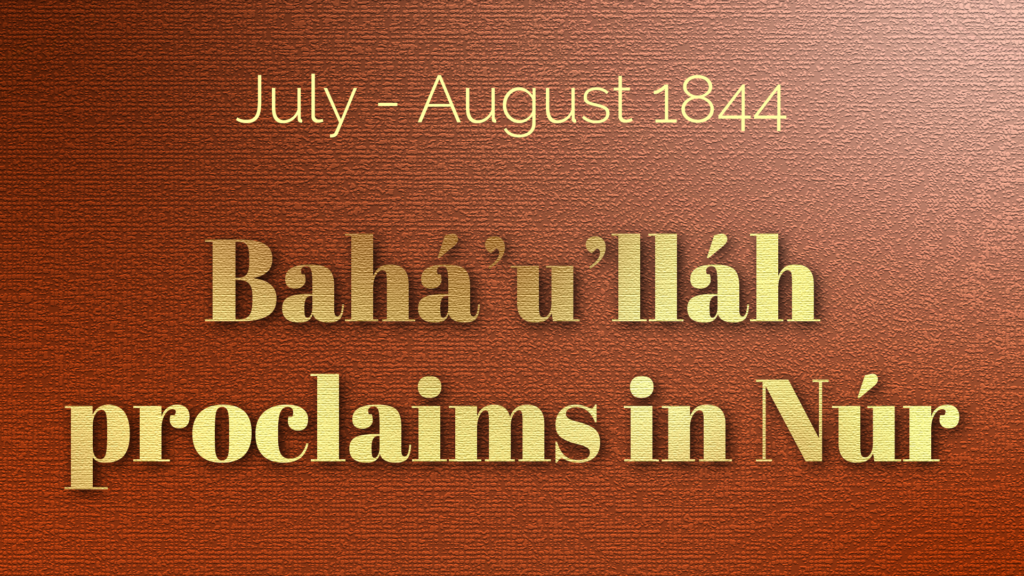
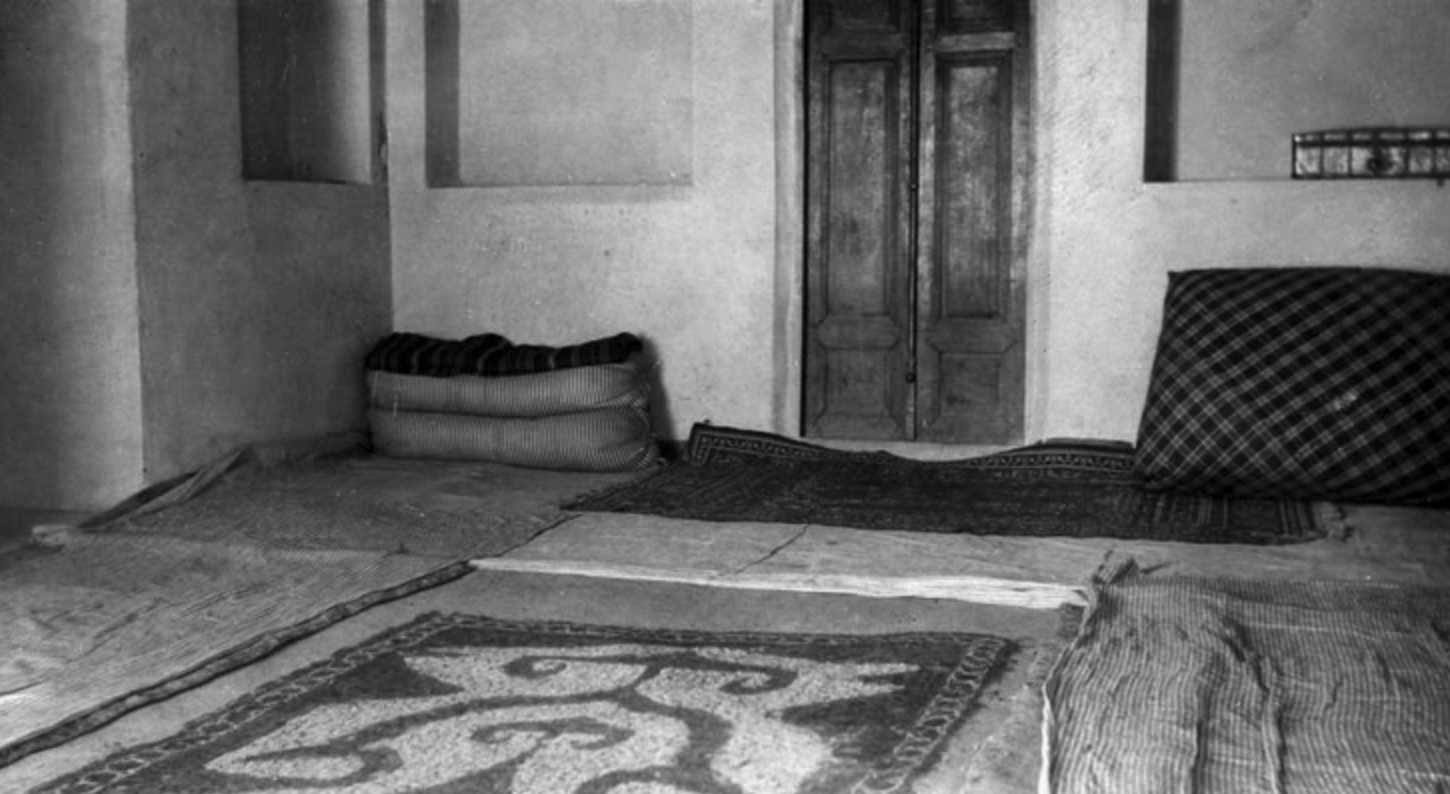
Bahá’u’lláh's room in His house in Takur, Mázindarán, kept in its original condition. Photographer: Effie Baker, c. 1930. © Bahá'í International Community. Source: The Life of Bahá'u'lláh: A Photographic Narrative.
After Bahá'u'lláh became a Bábí, He almost immediately arose on a two-month teaching journey to His native district of Núr, in July and August 1844. All the innate qualities He had honed in His youth, His mastery of argument, His knowledge, His eloquence, His profound understanding of theological subjects, became keener, more acute, and more penetrating when they were turned to the defense and promulgation of the Bábí Faith. Bahá'u'lláh soon became the leading exponent of the newborn Bábí Faith.
Bahá'u'lláh’s extraordinary spirit and eloquence soon gained many prominent and influential believers to the Bábí Faith, but also provoked hostility and intense opposition.
Mullá Ḥusayn, as instructed, sent the Báb a detailed report describing Bahá'u'lláh’s embrace of the Bábí Faith, how He immediately arose to proclaim the Cause in Núr, and His astonishing success. The Báb received the report on 10 October 1844, and was filled with profound joy for days after, His uncle often hearing the Báb, exultingly repeating the words, “How marvellous, how exceedingly marvellous, is that which has occurred between the months of Jamádi and Rajab! [July and August]”
H.M. Balyuzi, Bahá'u'lláh: The King of Glory, page 39.
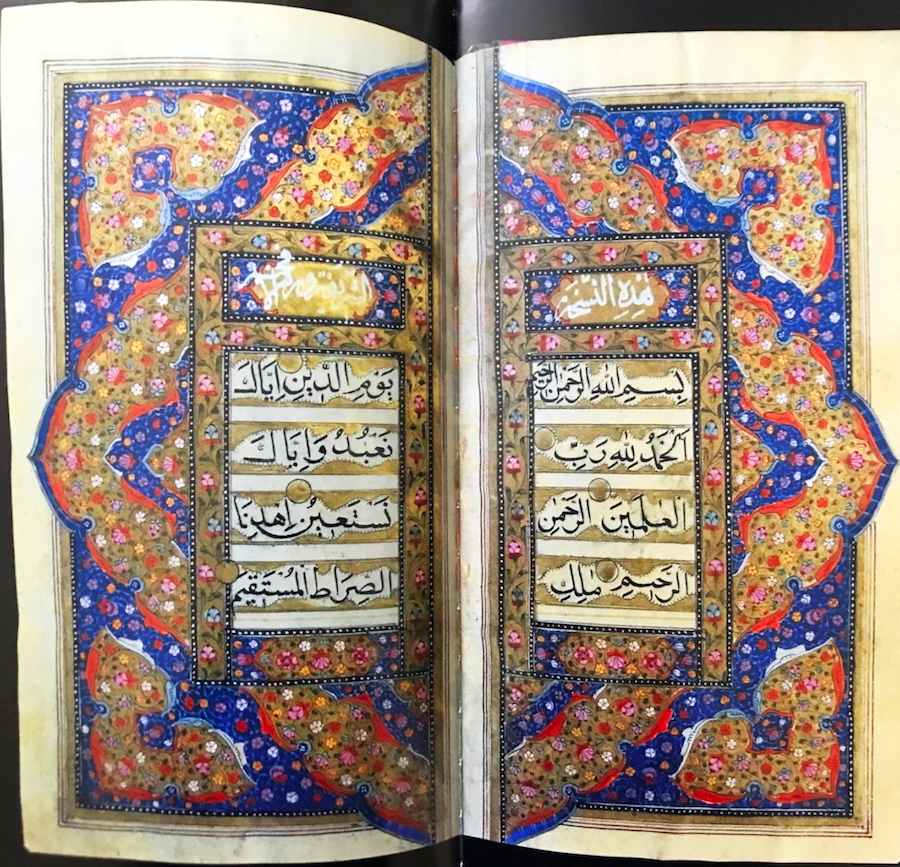
A 17th century illumination of the opening verses of the first chapter of the Holy Qur'án, the Surah al-Fatihah. This is the Surah which Bahá'u'lláh was in the midst of revealing a commentary on when the two students arrived. Details about the illumination and photograph from the website: Qu'ran Wiki: Studying Divine Speech.
Mullá Muḥammad was the son of Bahá'u'lláh’s relative and friend, the now-deceased famed mujtahid of Yálrúd. He had taken over for his father, and, pressured by his students to challenge Bahá'u'lláh's message from a doctrinal standpoint, he sent his two best students to Dárkalá, Bahá'u'lláh's winter resort on the Caspian Sea. When the men arrived, Bahá'u'lláh was revealing a commentary on the opening chapter of the Qur’án, entitled “The Seven Verses of Repetition.”
When the two men heard Bahá'u'lláh’s persuasive eloquence, luminous discourse and extraordinary delivery on such a lofty theme, they were utterly powerless to challenge Him. One of them arose, walked back, and stood by the door reverently. He would later tell his friend that he felt powerless to question Bahá'u'lláh. All of his questions had vanished from his mind. Both men sent to challenge Bahá'u'lláh had become Bábís upon simply encountering Him.
Nabíl, The Dawn-Breakers, page 116.
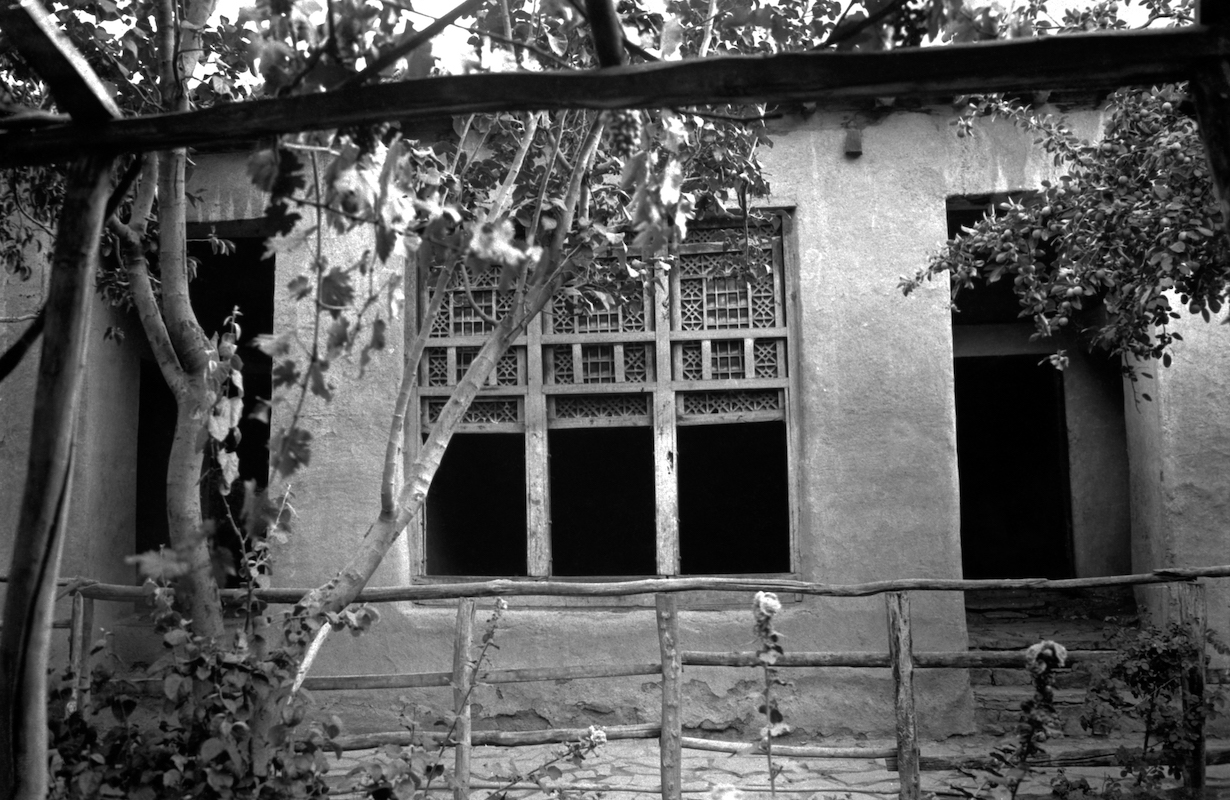
The house of Bahá’u’lláh in Takur, Mázindarán, c. 1930. © Bahá'í International Community. Bahá'í Media Bank.
News of Mullá Muḥammad’s two envoys converting to the Bábí Faith instantly upon meeting Bahá'u'lláh spread like wildfire through the district of Núr, and it roused the inhabitants from their lethargy. Soon, every type of person was flocking to Bahá'u'lláh's home: Muslim clergy, state officials, traders, peasants, many of whom became Bábís. Some of them told Bahá'u'lláh that the triumph of the Faith would be complete if Mullá Muḥammad himself accepted the Cause.
Bahá'u'lláh responded that His sole purpose in coming to Núr had been to proclaim the Bábí Faith, and that He intended to visit Mullá Muḥammad in the nearby village of Sa’adat-Ábád, and teach him the Faith.
Nabíl, The Dawn-Breakers, pages 116-117.
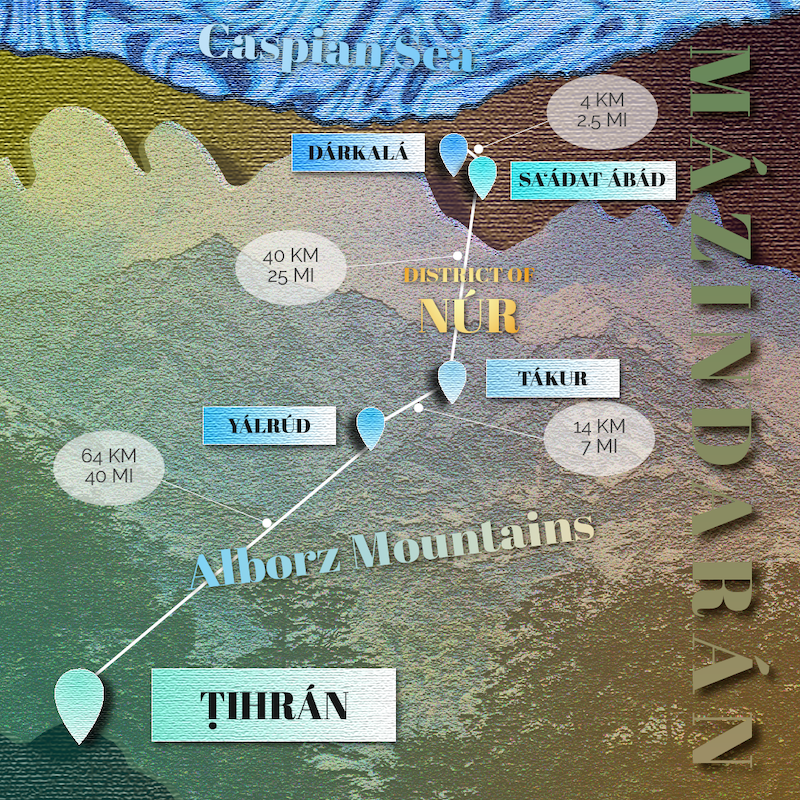
Map of the villages Bahá'u'lláh visited in His home district of Núr during His proclamation for which we have historical information. This map was drawn from the exact map included by Hand of the Cause Ḥasan Balyuzi in Bahá'u'lláh: The King of Glory, page 38. © Violetta Zein.
As soon as He had spoken those words, Bahá'u'lláh started for Sá'adat-Ábád, trailed by a number of His followers. Mullá Muḥammad received Bahá'u'lláh with great ceremony, but Bahá'u'lláh immediately and clearly stated His purpose:
“I have not come to this place to pay you an official or formal visit. My purpose is to enlighten you regarding a new and wondrous Message, divinely inspired and fulfilling the promise given to Islám.”
Bahá'u'lláh offered to clear up any misconceptions the mujtahid had about the Bábí Faith which were hindering him from recognizing the truth, but Mullá Muḥammad's response was patronizing and dismissive. He said:
“I undertake no action unless I first consult the Qur’án.”
He explained to Bahá'u'lláh that his technique for resolving difficulties was opening the Qur’án at random and consulting the first verse of that page, which informed his course of action. Bahá'u'lláh raised no objection to his method, and mujtahid called for a Holy Qur’án. He opened it, his eyes fell on a verse, and he shut the Holy Book, saying he deemed it “inadvisable to proceed further with this matter.” Unwilling to humiliate the man further, Bahá'u'lláh rose, asked to be excused and bid Mullá Muḥammad a cordial farewell.
Nabíl, The Dawn-Breakers, page 117.
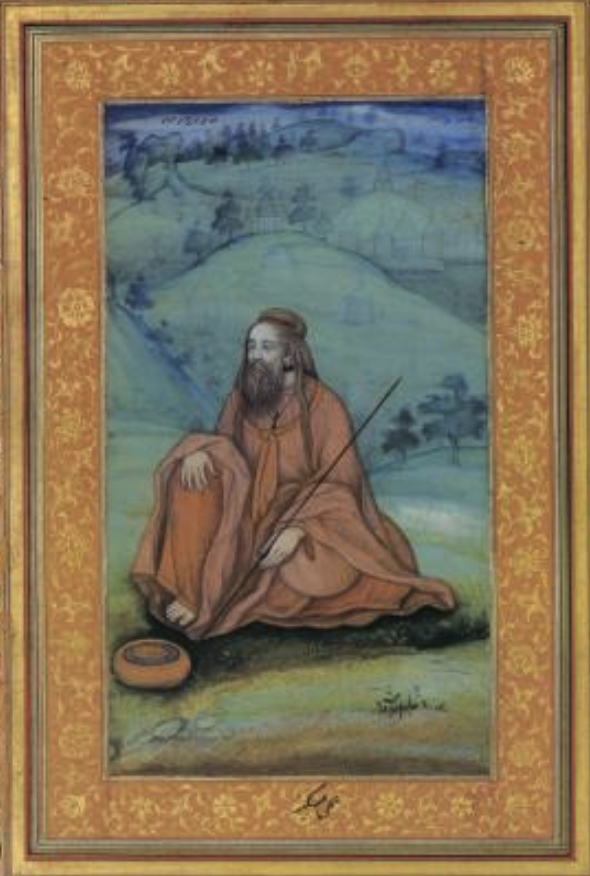
A 17th century Persian miniature of a dervish. From the website IslamOriente.
One day, as He was traveling through Núr on a riding excursion with His followers, Bahá'u'lláh came upon a dervish, seated by the roadside, by the bank of a brook. Alone, the young man, his hair disheveled, was occupied with cooking and eating food on a fire he had kindled. Bahá'u'lláh approached the young dervish and lovingly asked: "Tell Me, dervish, what is it that you are doing?”
The young man replied, bluntly: “I am engaged in eating God. I am cooking God and am burning Him.”
Bahá'u'lláh loved the young man's simple manners and candid reply, and He began a conversation with the dervish, speaking to him freely and tenderly. After a short time, Bahá'u'lláh's transformative effect on the dervish was complete. He had become enlightened as to the true nature of God, his mind freed from the idle fancies of dervish culture, he recognized Bahá'u'lláh’s true station.
The dervish's name was Muṣṭafá Big-i-Sanandají. He was originally from Sanandij, nearly 490 kilometers (300 miles) away in Kúrdistán. After he recognized Bahá'u'lláh, Muṣṭafá Big adopted the name Majzúb "the Attracted," and started following his Beloved, changing verses of a mystical love-song he composed spontaneously, singing the praises of Bahá'u'lláh. The refrain of Majzúb’s poem went as follows:
“Thou art the Day-Star of guidance, Thou art the Light of Truth. Unveil Thyself to men, O Revealer of the Truth.”
In later years, Majzúb's poem would be widely circulated among Ṣúfís, but no one knew it was about Bahá'u'lláh. Majzúb alone had seen Bahá'u'lláh’s true station, one of a select rare handful of people who would be able to perceive it before His Revelation in the Siyáh-Chál.
Nabíl, The Dawn-Breakers, pages 117-118.
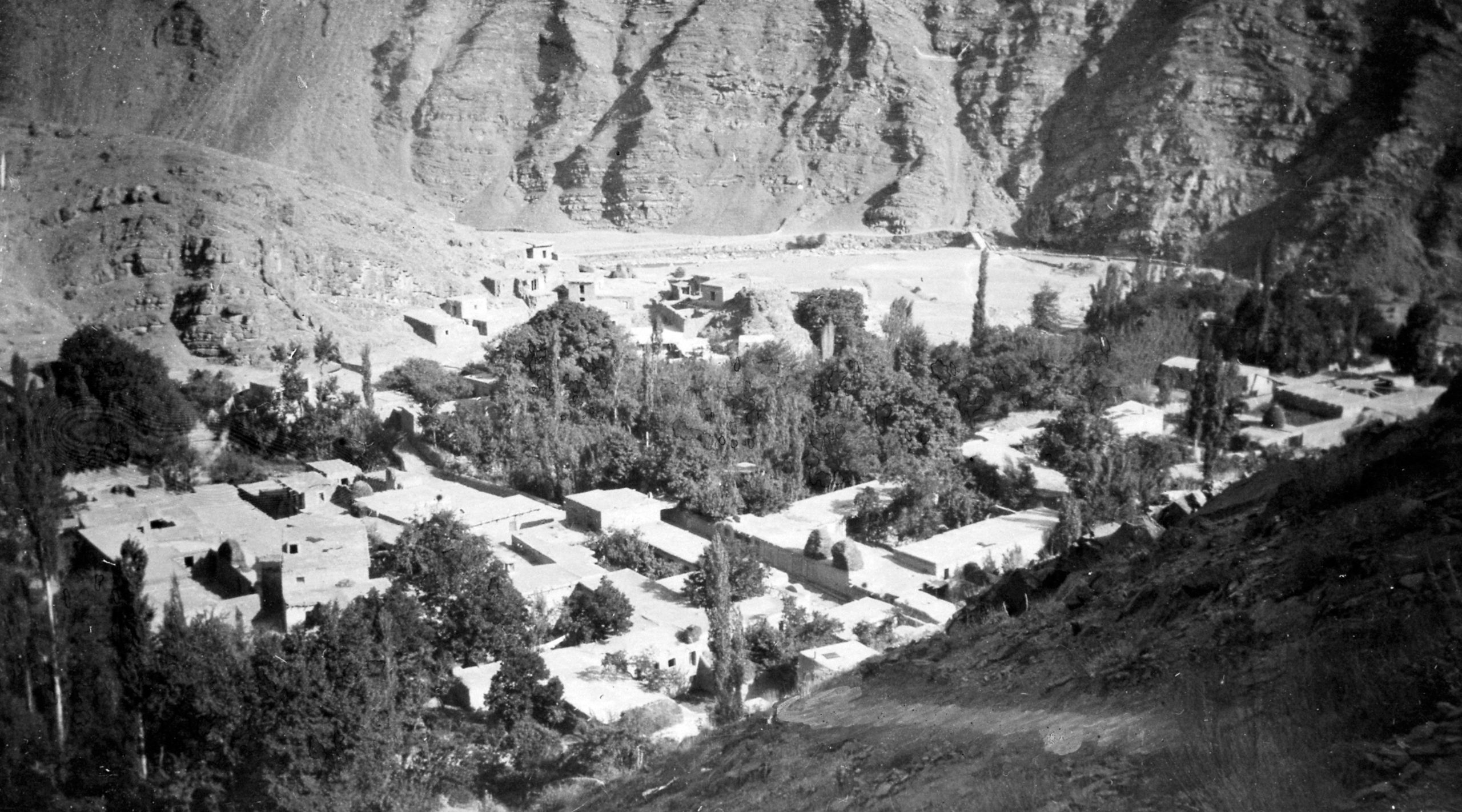
1930 photograph of Tákur, Bahá'u'lláh's ancestral home in the north of Iran, where He undertook a two-month teaching journey in July and August 1844. © Bahá'í International Community. Bahá'í Media Bank.
Bahá’u’lláh’s two-month proclamation journey to Núr in the summer of 1844, immediately after He had embraced the Bábí Faith, took place approximately two months after the Declaration of the Báb, and it yielded far-reaching results, infusing the movement behind the newborn Dispensation with a tremendous and remarkable energy.
Bahá'u'lláh had won over the hearts of the people of Núr. He had stirred their souls to their depths, and enrolled many of them into the Bábí Faith through His magnetic eloquence, the purity of His life, the dignity of His bearing, His masterful arguments, and His constant, all-encompassing loving-kindness,
Nabíl testifies to the impact Bahá'u'lláh had on Núr, seeming to quicken even the stones and trees:
“Such was the effect of words and deeds, as He went about preaching the Cause and revealing its glory to His countrymen in Núr, that the very stones and trees of that district seemed to have been quickened by the waves of spiritual power which emanated from His person. All things seemed to be endowed with a new and more abundant life, all things seemed to be proclaiming aloud: “Behold, the Beauty of God has been made manifest! Arise, for He has come in all His glory.”
The Bábís of Núr consolidated the solid foundations left by Bahá'u'lláh by continuing to teach and spread the Bábí Faith. Many were persecuted in later years, and some became martyrs for the Cause. The province of Mázindarán, and more specifically, the district of Núr, have the distinction of being the first in Persia to passionately embrace the Message of the Báb. Núr, nestled in the mountains of Mázindarán, caught the first rays of the sun of the Bábí Faith that had arisen in Shíráz, through the efforts of Bahá'u'lláh, the One destined to make that sun shine in its full splendor.
Nabíl, The Dawn-Breakers, pages 118-119.
